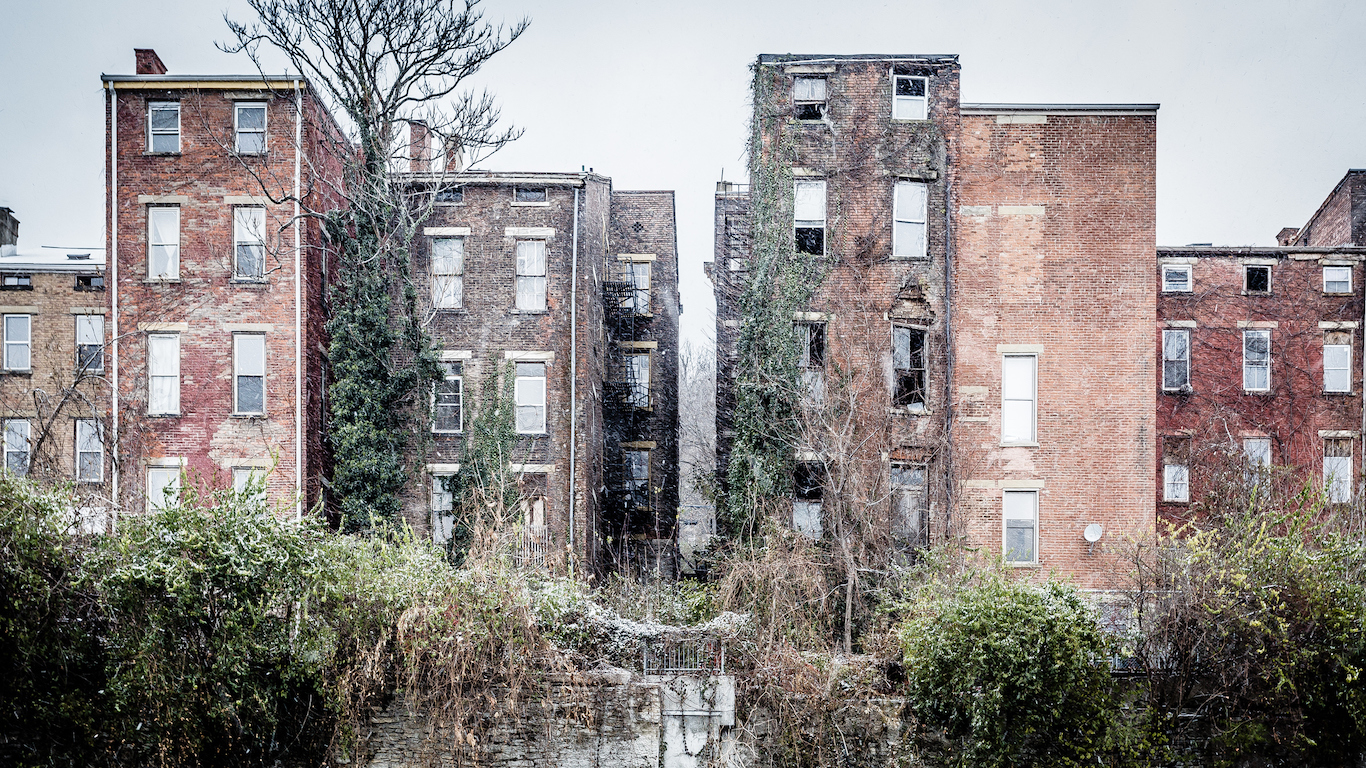

With the coronavirus keeping Americans confined to their homes and mortgage rates at record lows, home sale volume this year hit the highest level in over a decade in the United States. Despite the rush to buy homes, an estimated 1.6 million houses in the United States remain unoccupied.
Most unoccupied homes in the United States are classified as investment properties, meaning they are either on the rental market, or will eventually be resold, or both. Other vacant properties are effectively abandoned. Whatever the reason, empty homes are often concentrated in specific neighborhoods in certain cities. In over a dozen U.S. ZIP codes, more than one in every five homes sit unoccupied.
24/7 Wall St. reviewed the share of vacant single-family homes as of the end of the third quarter of 2020 to identify the 30 ZIP codes with the highest vacancy rates — America’s ghost towns. Vacancy rates in these areas, which were calculated by ATTOM Data Solutions using tax assessor data, range from 15.9% to 33.9% — more than 10 times the national vacancy rate. ZIP codes in popular vacation destinations, where high vacancy rates are likely seasonal, were excluded from our analysis.
The majority of ZIP codes on this list tend to be in urban areas in the South and Midwest, including many Rust Belt cities. These areas have been hollowed out by the decline of American manufacturing and currently have little to offer in the way of economic opportunity. In fact, with only a couple of exceptions, the population declined in each of these ZIP codes in the last five years. Here is a look at the cities Americans are abandoning.
With these areas often economically distressed, poverty rates tend to be high in these ZIP codes. Low incomes, in tandem with population decline and the resulting reduced demand for housing, have driven down real estate values. The average home sale price nationwide in the third quarter of 2020 was $387,000. Meanwhile, in all but five ZIP codes on this list, most homes are worth less than $70,000 — and in nearly every ZIP code on this list there are homes in foreclosure. Conversely, here is a look at the most expensive ZIP codes in the country.
Click here to see 30 American ghost towns.
Click here to read our detailed methodology.
30. ZIP 43610 (Toledo, Ohio)
> Vacant homes: 292 (15.9% of total)
> 5-yr. population change: -7.5%
> Population: 4,343
> Median home value: $50,100
The majority of ZIP codes on this list are located in Midwestern Rust Belt cities, and Ohio’s 43610 postal code is one of them. The area, located in Toledo, lies largely southeast of Interstate-75 and the Ottawa River, covering part of the Olde Towne neighborhood. Nearly 300 homes in the area, or 15.9% of all area homes, sit unoccupied. Of those homes, 237 are classified as investment properties, indicating that owners may be holding to sell at a later date or looking for renters.
The area’s high vacancy rates are likely due in part to population decline. Over the last five years, the number of people living in the postal code has fallen by 7.5%.
[in-text-ad]
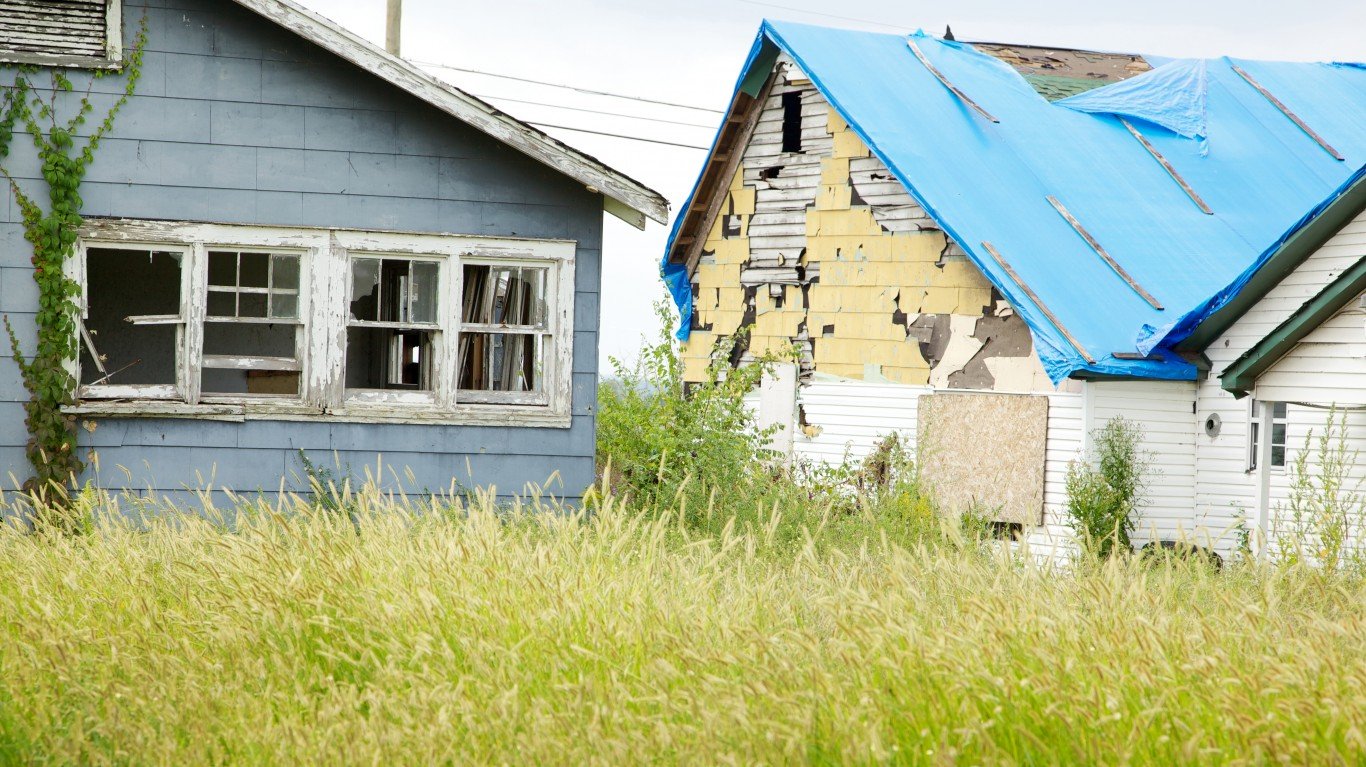
29. ZIP 35218 (Birmingham, Alabama)
> Vacant homes: 318 (15.9% of total)
> 5-yr. population change: -4.2%
> Population: 7,178
> Median home value: $65,200
The 35218 ZIP code is one of several in Alabama to rank on this list. An estimated 318 area homes, or 15.9% of the 1,994 total homes in the area, are unoccupied. Areas with high vacancy rates often have low real estate values — and the 35218 postal code is no exception. The typical area home is worth just $65,200 — less than one-third of the $204,900 value of the typical American home.
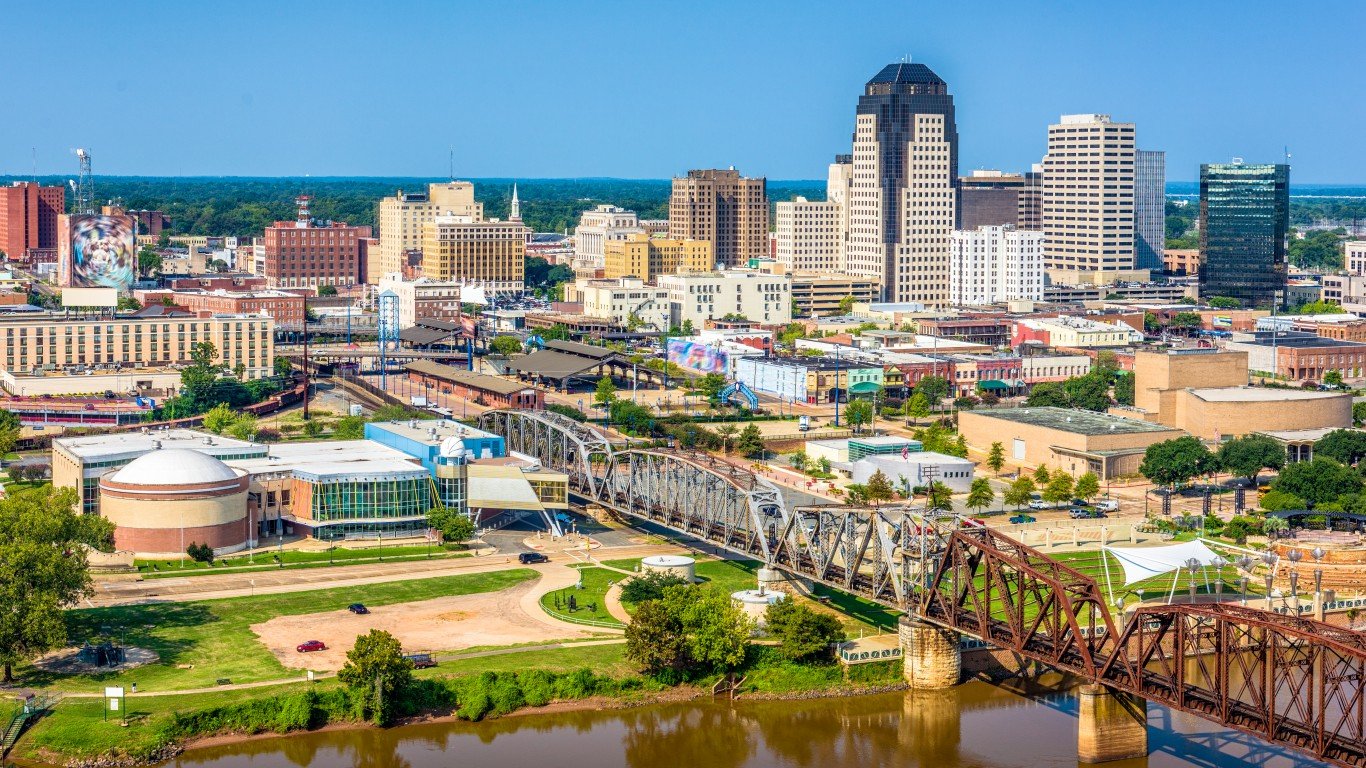
28. ZIP 71101 (Shreveport, Louisiana)
> Vacant homes: 330 (16.0% of total)
> 5-yr. population change: -23.4%
> Population: 6,694
> Median home value: $68,500
The 71101 ZIP code in Shreveport, Louisiana, has reported a staggering population decline in the last half decade, at nearly 25%. A smaller population means reduced demand for housing — which can result in lower property values and high vacancy rates.
Currently, about 16% of homes in the 71101 ZIP code are unoccupied. Additionally, the typical area home is worth just $68,500, about one-third the value of the typical American home.
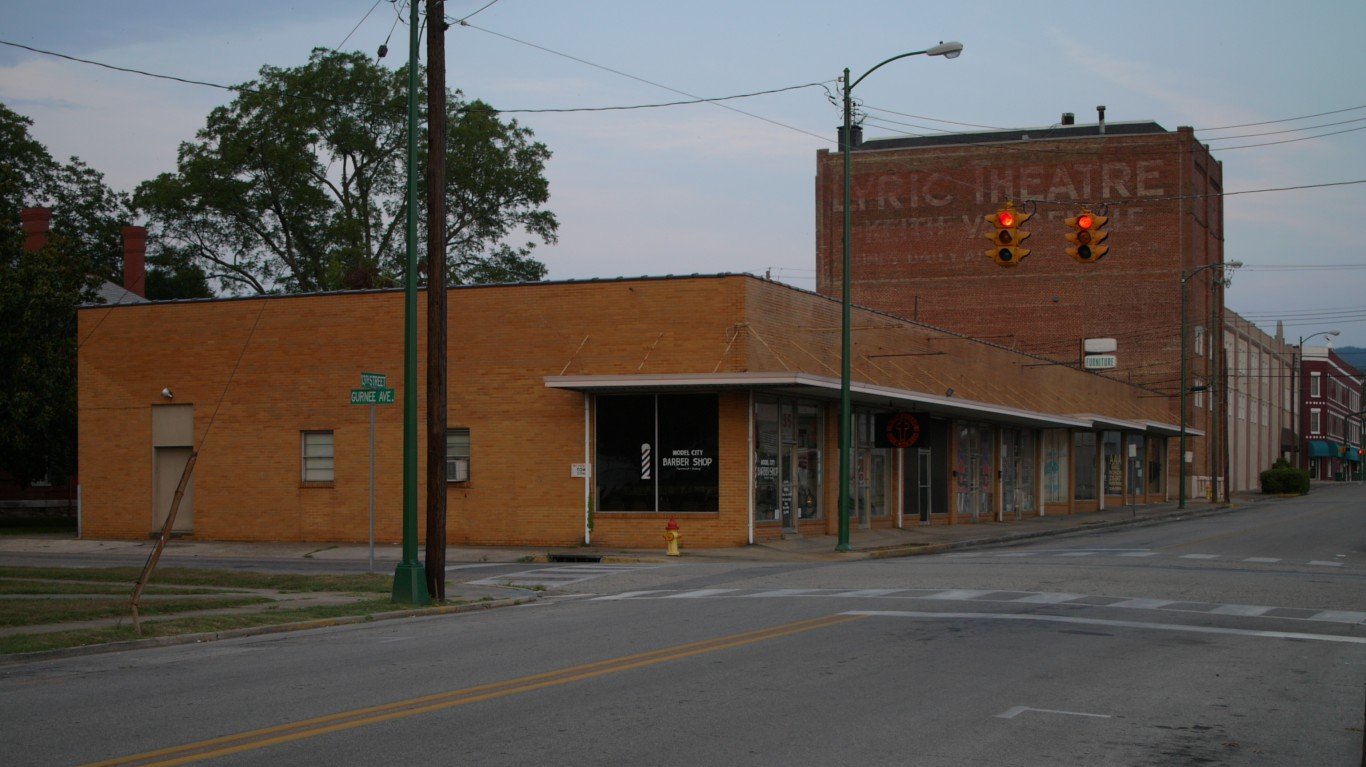
27. ZIP 36201 (Anniston, Alabama)
> Vacant homes: 1,097 (16.2% of total)
> 5-yr. population change: -7.4%
> Population: 18,052
> Median home value: $66,700
The 36201 postal code, which covers western Anniston, Alabama, has one of the highest vacancy rates in the country. Over 1,000 of the 6,781 area homes are unoccupied. The area’s high vacancy rate is due to decreasing demand, driven in part by population decline. There are currently about 18,000 people living in the 36201 ZIP code, down 7.4% from five years ago.
As is often the case in high-vacancy areas, real estate is cheap in western Anniston. The typical area home is worth just $66,700, a fraction of the $204,900 the typical home nationwide is worth.
[in-text-ad-2]
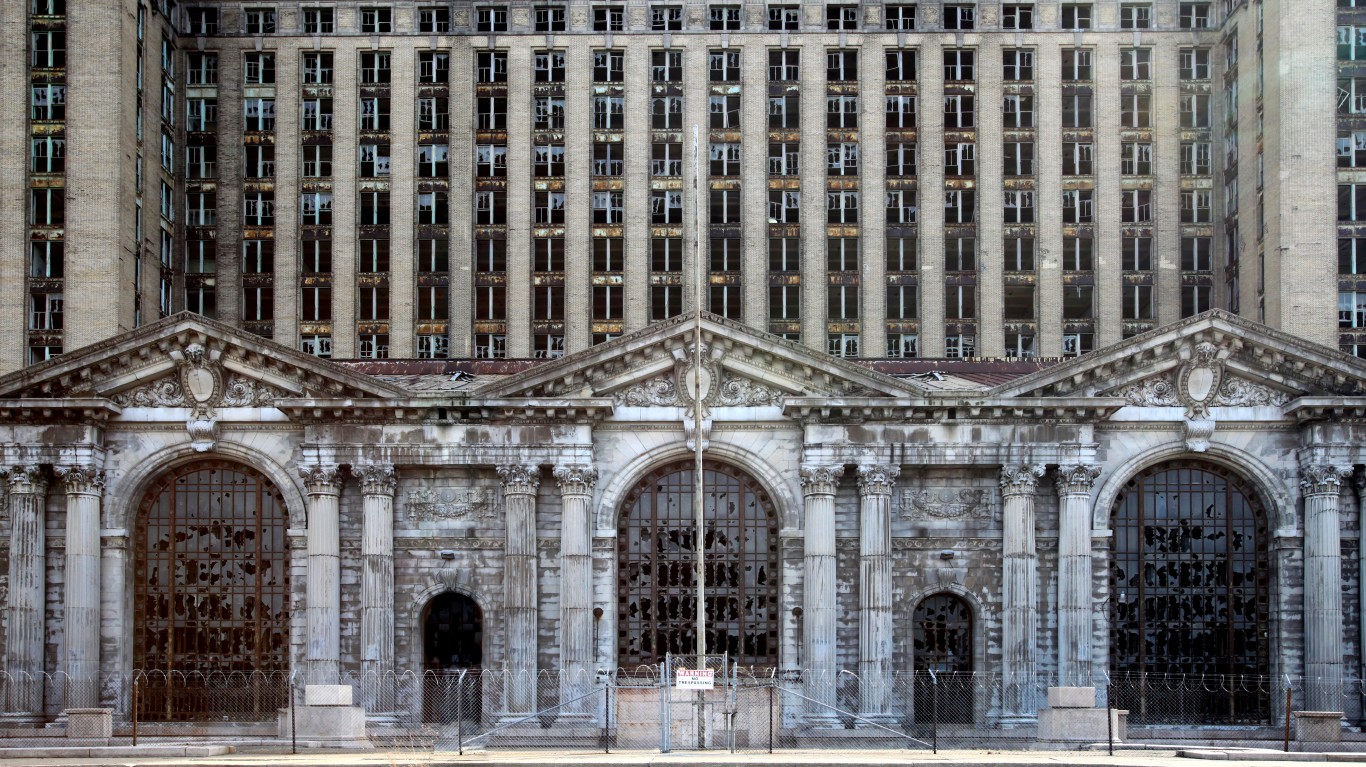
26. ZIP 48208 (Detroit, Michigan)
> Vacant homes: 317 (16.2% of total)
> 5-yr. population change: -8.0%
> Population: 9,196
> Median home value: $56,700
Many postal codes on this list are located in Rust Belt cities and have been hollowed out by decades of economic decline. Detroit’s 48208 ZIP code is one of them. More than 300 of the area’s 1,958 homes are unoccupied.
The area’s high vacancy rate is due in part to population decline. Over the last five years, the number of people living in the area fell by 8.0% — in keeping with longer term population decline across the city as a whole. After peaking at 1.8 million people in 1950, Detroit’s population has since plummeted and the city is now home to fewer than 675,000 people.
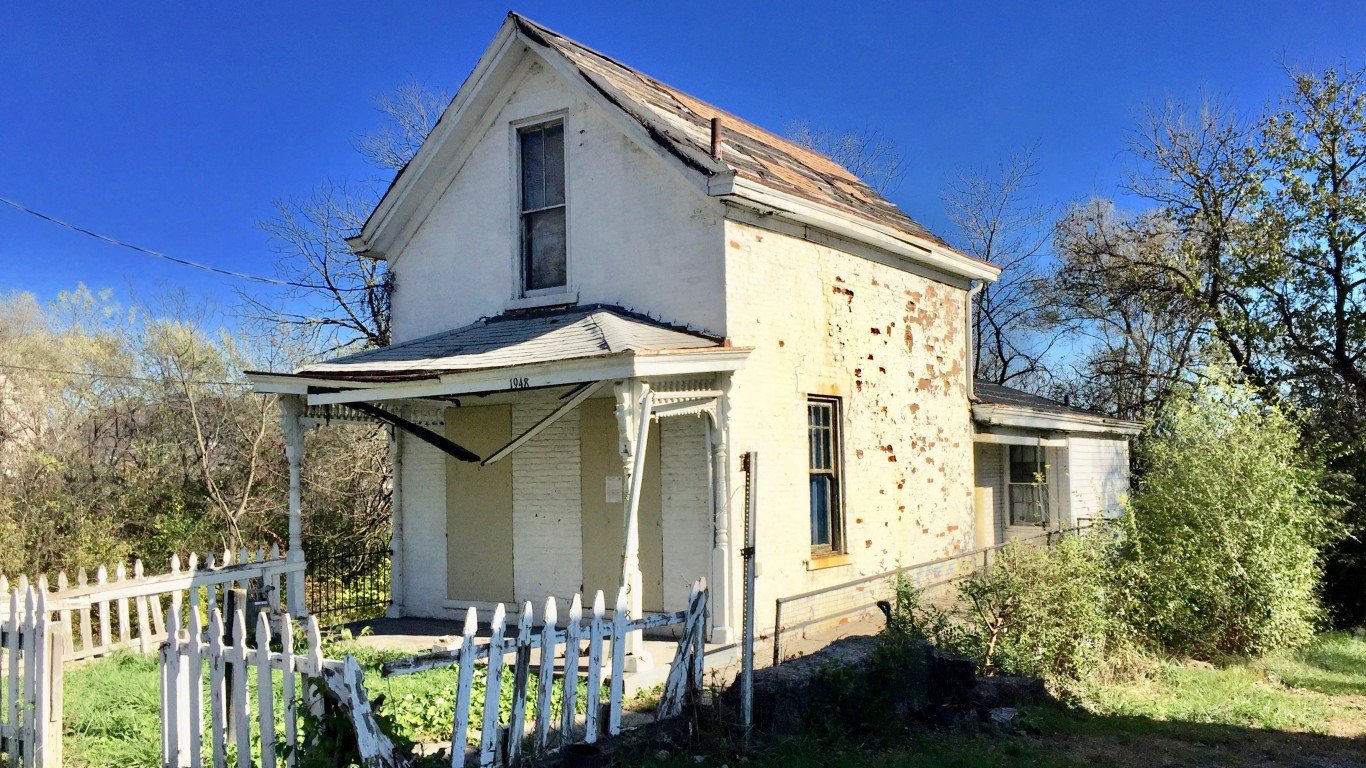
25. ZIP 45214 (Cincinnati, Ohio)
> Vacant homes: 267 (16.4% of total)
> 5-yr. population change: -6.6%
> Population: 7,791
> Median home value: $70,200
The 45214 ZIP code, which extends from just west of Cincinnati’s Washington Park up through the West End neighborhood over Mill Creek and into the Fairmount neighborhood, is one of many parts of Ohio to rank on this list. There are currently 267 unoccupied homes in the area, or over 16% of all homes.
The majority of vacant properties in the area are classified as investment properties, meaning they are likely either on the rental market or waiting to be sold at a profit by the owner. And despite the high vacancy rate, property in the area appears to be appreciating in value. The typical area home is worth $70,200, up from $62,000 in 2014.
[in-text-ad]
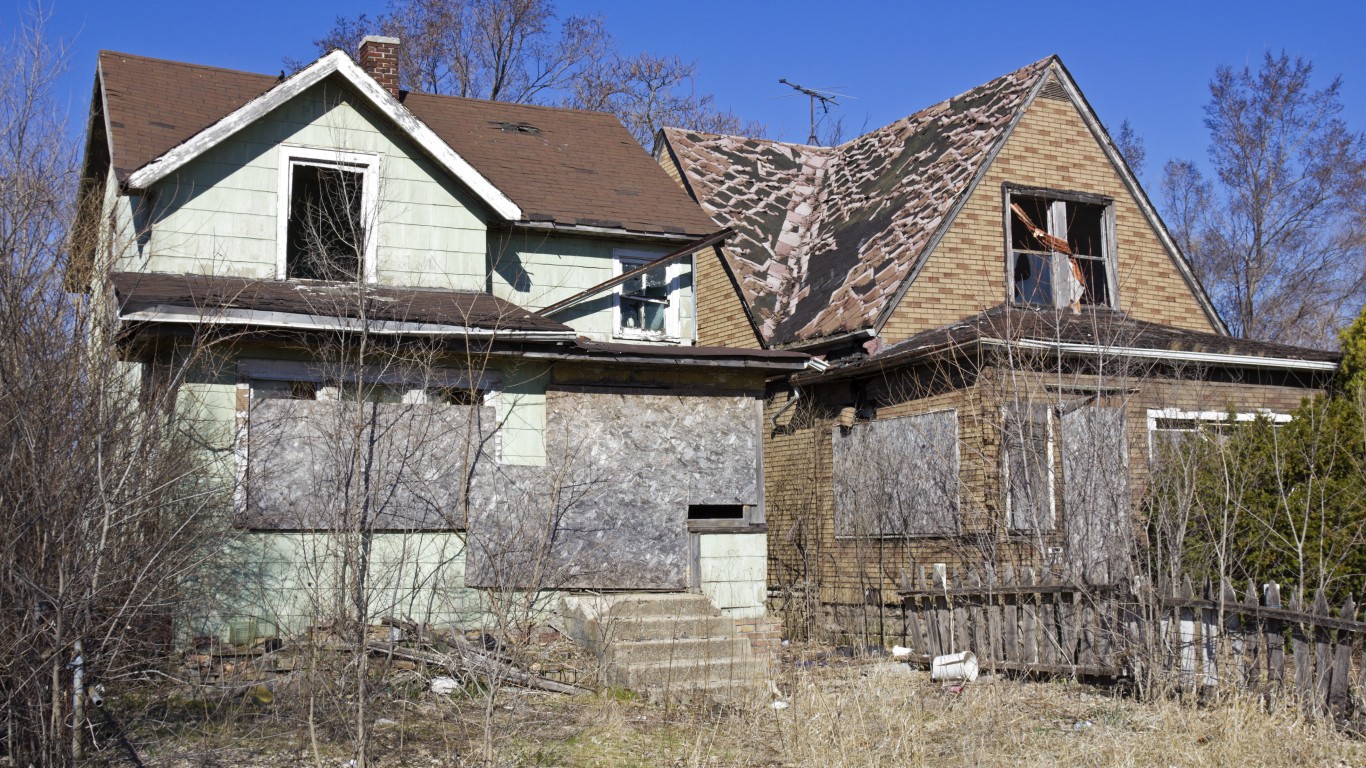
24. ZIP 46404 (Gary, Indiana)
> Vacant homes: 1,060 (16.7% of total)
> 5-yr. population change: +0.2%
> Population: 17,014
> Median home value: $69,000
The 46404 ZIP code is one of several parts of the Rust Belt city of Gary, Indiana, to rank on this list. The area is located in west-central Gary, largely in between Interstate 90 and Interstate 94. Over 1,000 of the area code’s 6,344 homes are vacant, and many of those are likely abandoned.
Gary, a town effectively built around a steel plant, has been in steady decline along with the American steel industry itself since the mid-20th century. The city’s population peaked at over 178,000 in 1960 and has since been reduced by more than half.
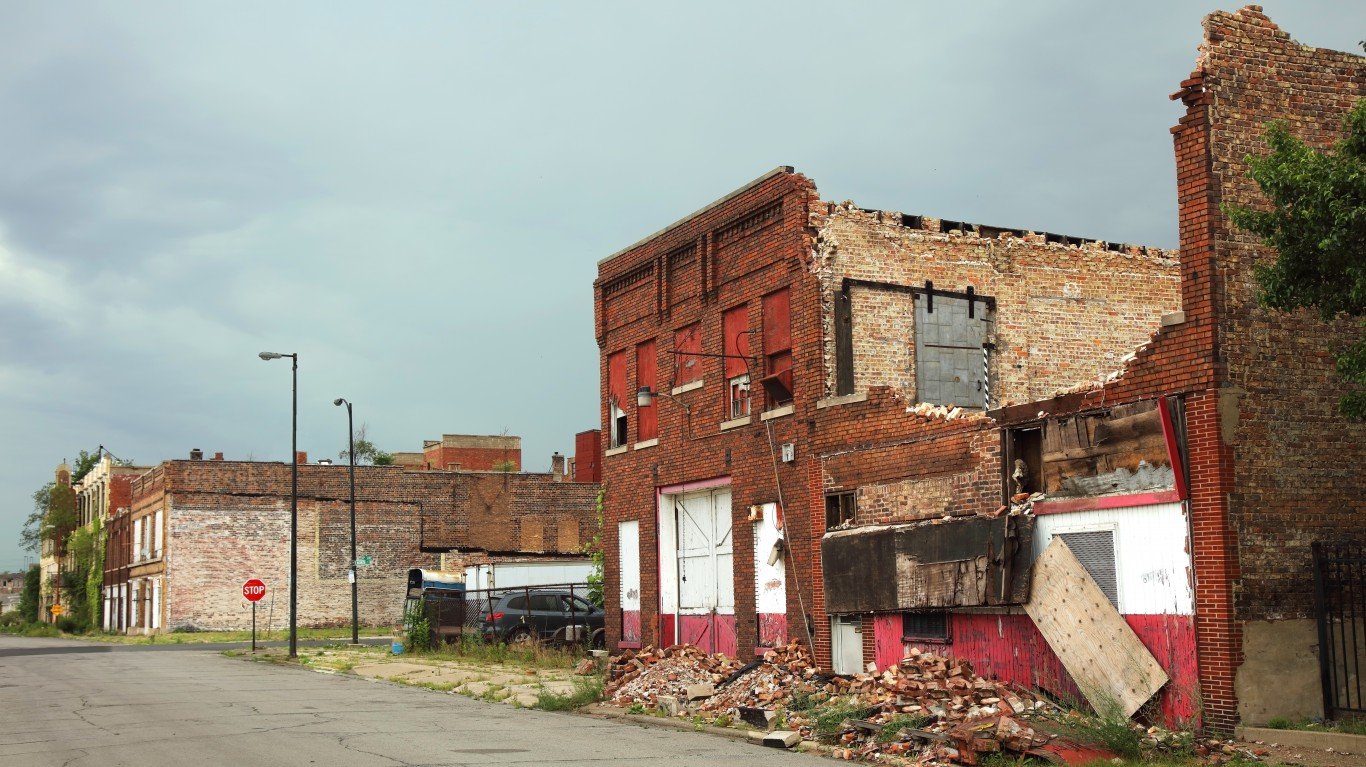
23. ZIP 46406 (Gary, Indiana)
> Vacant homes: 579 (16.8% of total)
> 5-yr. population change: -3.5%
> Population: 9,554
> Median home value: $56,400
Since building a plant in the city in 1906, U.S. Steel was the economic backbone of Gary, Indiana, for decades. As the steel industry declined, so did Gary. The city has faced widespread socioeconomic problems, including drugs, violent crime, and widespread poverty. Due in part to longer-term population decline, today, 579 homes in the 46406 ZIP code in western Gary are vacant .
As is often the case, many of the vacant properties in this part of Gary are investment properties — meaning they are likely either on the rental market or waiting to be sold at a profit by the owner. Currently, the typical area home is worth just $56,400.
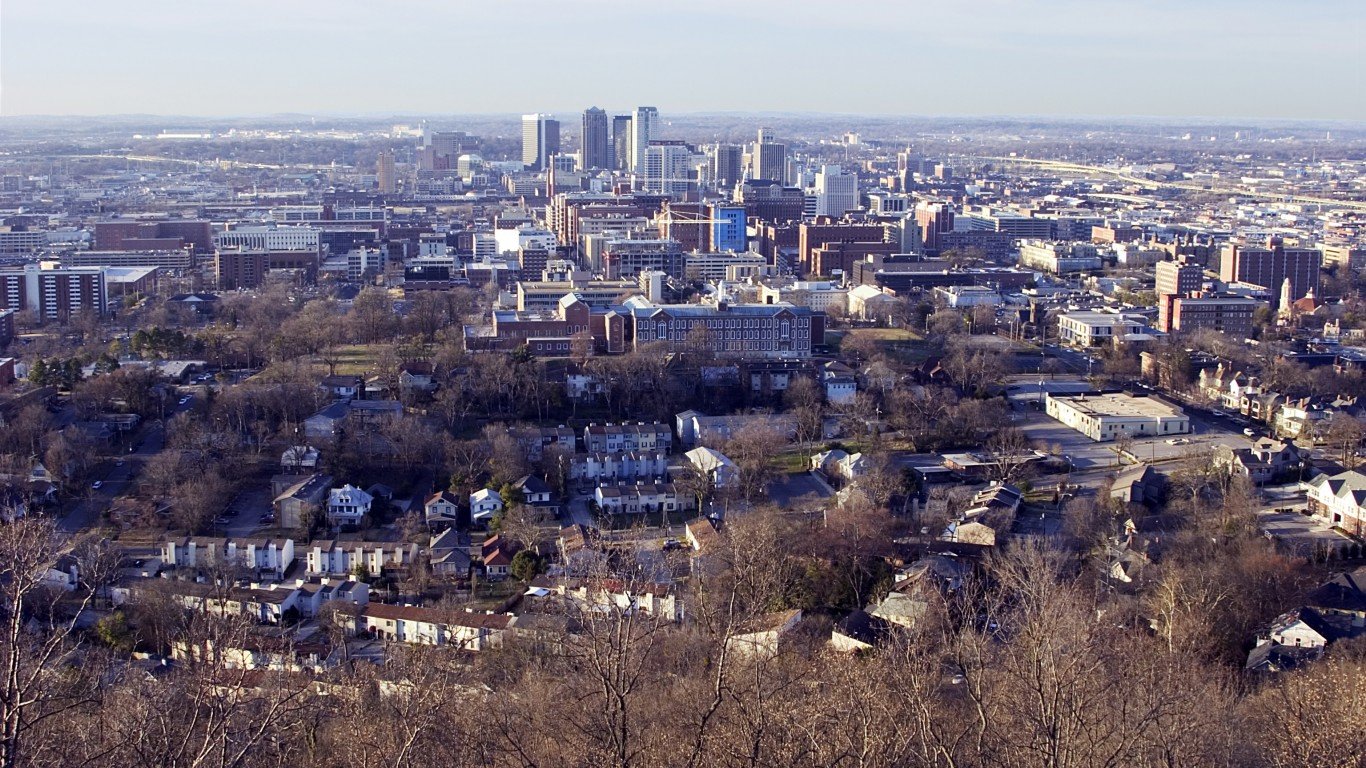
22. ZIP 35204 (Birmingham, Alabama)
> Vacant homes: 600 (17.1% of total)
> 5-yr. population change: -13.8%
> Population: 9,399
> Median home value: $63,000
The 35304 ZIP code in central Birmingham has reported steep population declines in recent years. Since 2013, the number of people living in the postal code plummeted 13.8%. A smaller population and reduced demand for housing may help explain the area’s high vacancy rate. There are 600 area homes that are currently sitting unoccupied, or 17.1% of all area homes.
As is often the case in areas with high vacancy rates, Birmingham’s 35204 postal code is poor. Most households earn an annual income of less than $22,000, and nearly 38% of the local population live below the poverty line.
[in-text-ad-2]

21. ZIP 63133 (Saint Louis, Missouri)
> Vacant homes: 458 (17.2% of total)
> 5-yr. population change: -10.6%
> Population: 7,336
> Median home value: $54,200
The 63133 ZIP code in St. Louis, Missouri, sits just north of Washington University and is bisected by route 180. Nearly 500 homes, or 17.2% of all homes, in the area sit vacant.
As is the case in the majority of ZIP codes on this list, this part of St. Louis is reporting rapid population decline. The city lost 10.6% of its population in the last five years. The resulting reduced demand for housing has likely dragged down real estate values. The typical area home is worth just $54,200, down from $60,500 in 2014.
20. ZIP 60426 (Harvey, Illinois)
> Vacant homes: 1,593 (17.3% of total)
> 5-yr. population change: +2.3%
> Population: 28,924
> Median home value: $73,600
The 60426 ZIP code, located about 20 miles south of Chicago, has one of the highest vacancy rates in the country. Nearly 1,600 of the 9,227 homes in the area are unoccupied. Like most areas on this list, the 60426 area code is relatively poor, with most households earning about $30,000 or less annually and 30.7% of the population living below the poverty line. Unlike most other neighborhoods on this list, the 60426 ZIP code is growing. In the last five years, the local population increased by 2.3%, while the populations of most ZIP codes on this list are declining.
[in-text-ad]

19. ZIP 46016 (Anderson, Indiana)
> Vacant homes: 1,259 (17.7% of total)
> 5-yr. population change: -4.7%
> Population: 17,996
> Median home value: $46,300
There are 1,259 vacant properties in the 46016 ZIP code in Anderson, Indiana. The urban decay evidenced by the area’s large share of vacant properties is due in part to poor regional economic conditions. Some 34.6% of area residents live below the poverty line, more than double the 13.4% national poverty rate.
Anderson was one of several Indiana cities to benefit from the state’s natural gas boom at the end of the 19th century due to its proximity to the largest natural gas field in the country at the time. However, the economic boom was short-lived, as conservation efforts were not made, and resources were effectively depleted.
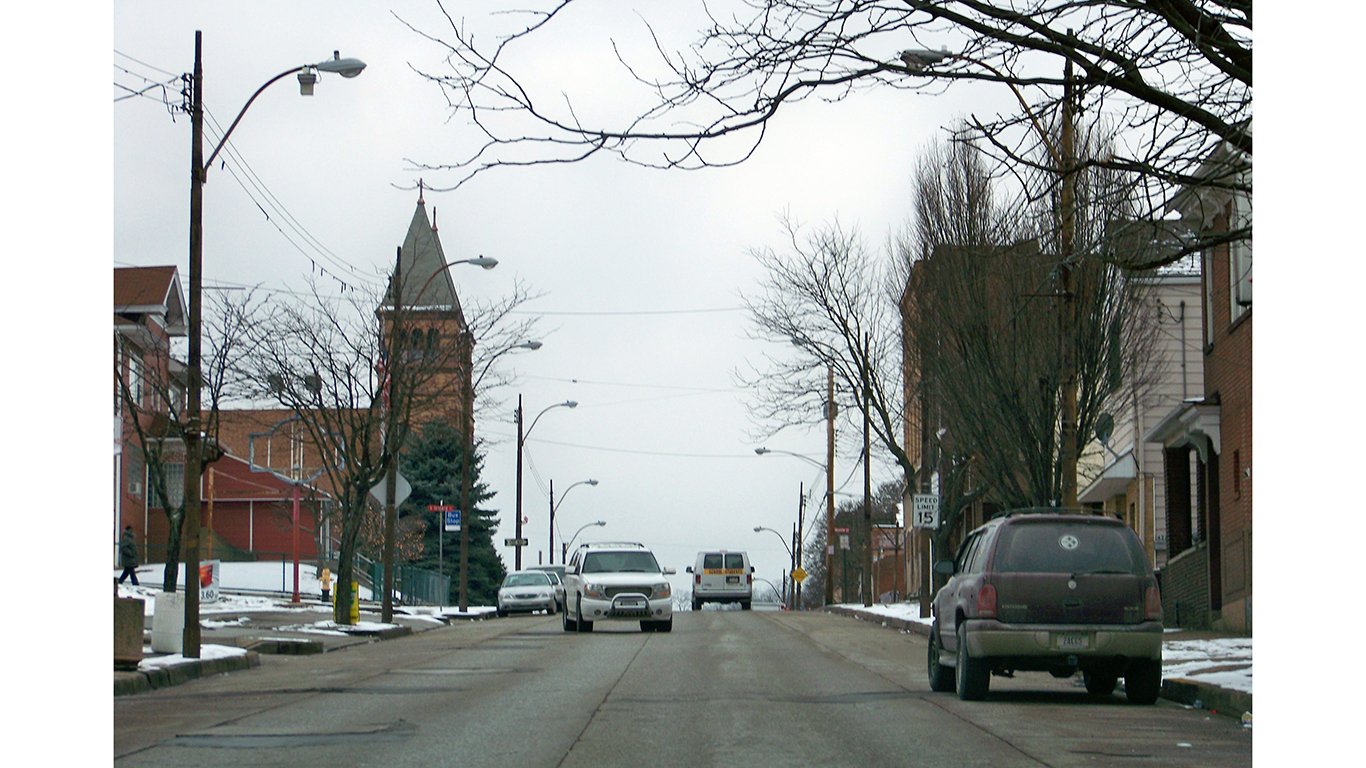
18. ZIP 15110 (Duquesne, Pennsylvania)
> Vacant homes: 368 (17.7% of total)
> 5-yr. population change: -0.7%
> Population: 5,544
> Median home value: $39,600
The 15110 ZIP code in western Pennsylvania sits along the west bank of the Monongahela River and covers the small city of Duquesne. Of the 2,078 residential properties in the area, 368 are vacant. Like many parts of the country on this list, the ZIP code around Duquesne is poor. Most area households earn less than $27,000 a year, and 40% of area residents live below the poverty line.
As is often the case in areas with mass vacancies, home values in the area are also low. The typical area home is worth just $39,600, not even a quarter of the national median home value.
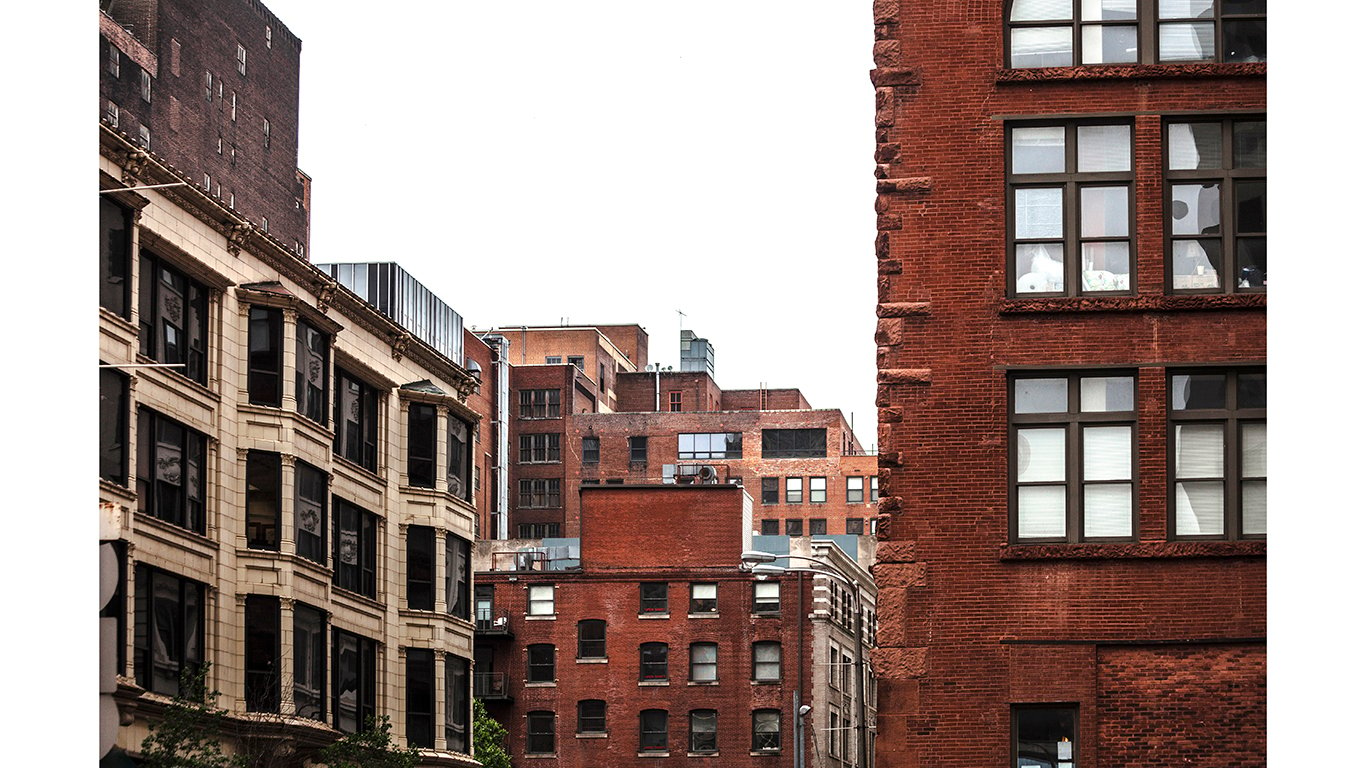
17. ZIP 63115 (St. Louis, Missouri)
> Vacant homes: 1,308 (17.8% of total)
> 5-yr. population change: -13.5%
> Population: 18,213
> Median home value: $55,900
The 63115 ZIP code in St. Louis is located just north of the Central West End neighborhood along O’Fallon Park. It is one of several parts of the Missouri city to have near nation-leading home vacancy rates. Some 1,308 area homes, or 17.8% of all homes in the area, are vacant.
Cities with high vacancy rates often report higher crime rates, and St. Louis is a relatively dangerous city. There were 1,927 violent crimes in St. Louis for every 100,000 people in 2019, well above the national violent crime rate of 367 per 100,000.
[in-text-ad-2]
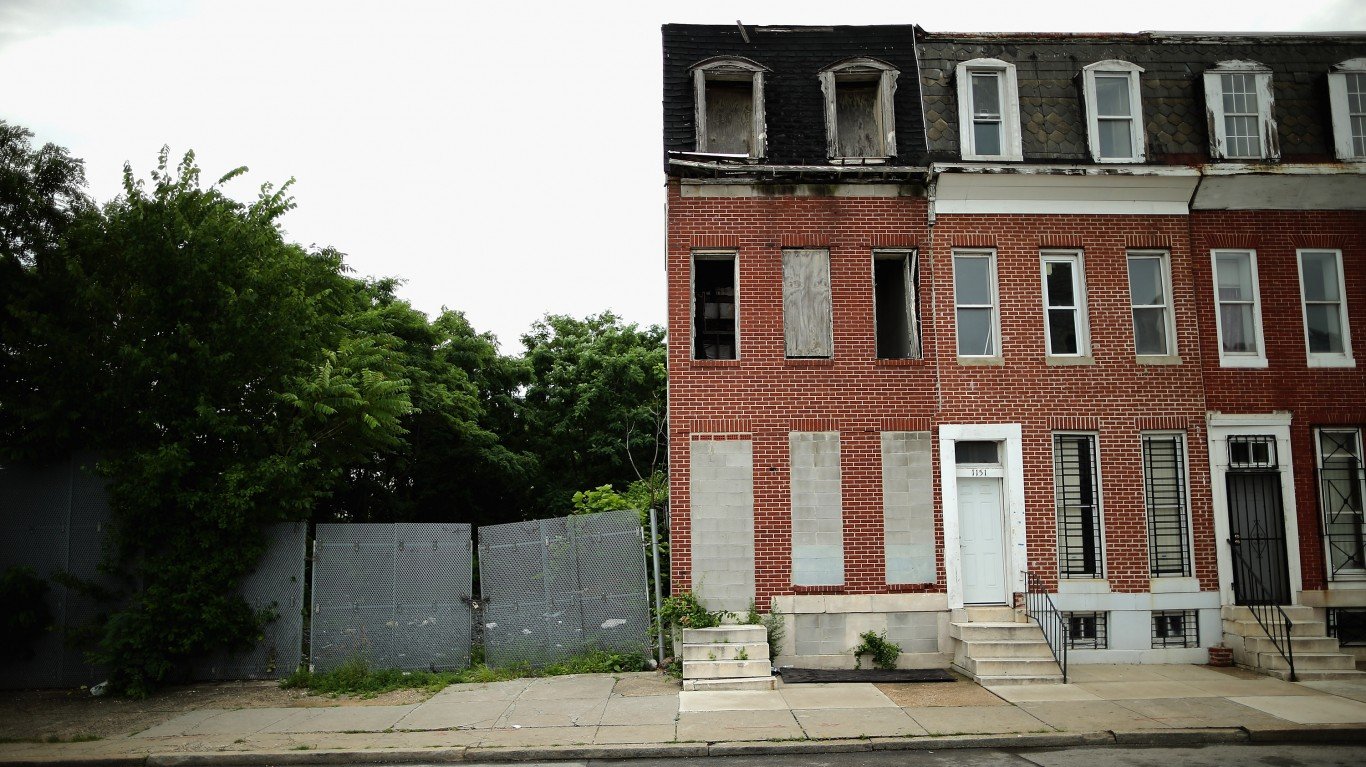
16. ZIP 21223 (Baltimore, Maryland)
> Vacant homes: 2,252 (17.8% of total)
> 5-yr. population change: -2.0%
> Population: 23,560
> Median home value: $72,800
Baltimore’s 21223 ZIP code is one of only a few mid-Atlantic areas — and one of only two zip codes in Maryland — to rank on this list. Located just west of Baltimore’s Inner Harbor, the 21223 ZIP code has one of the largest shares of vacant homes, at 17.8%.
The city of Baltimore as a whole has had a vacancy problem for over a decade, and there are currently about 18,000 vacant homes across the city. Currently, the city is implementing a multimillion dollar project to redevelop or raze vacant homes in an effort to address urban blight and revitalize communities.
15. ZIP 44507 (Youngstown, Ohio)
> Vacant homes: 367 (18.4% of total)
> 5-yr. population change: -2.3%
> Population: 5,409
> Median home value: $23,400
There are 367 vacant homes — nearly one in every five — in the 44507 zip code in the south-central part of Youngstown, Ohio. Population decline in recent years has likely exacerbated the problem. In the last five years, the number of people living in the area fell by 2.3%. As in most places reporting a population decline and a high vacancy rate, property values in the 44507 ZIP code are near rock bottom. The typical area home is worth just $23,400, about $181,500 below the value of the typical American home.
Economic problems and population decline across Youngstown began in the 1970s and ’80s, with the decline of the city’s once dominant steel industry. The lack of economic opportunity in the area remains a root cause of the high vacancy rate.
[in-text-ad]
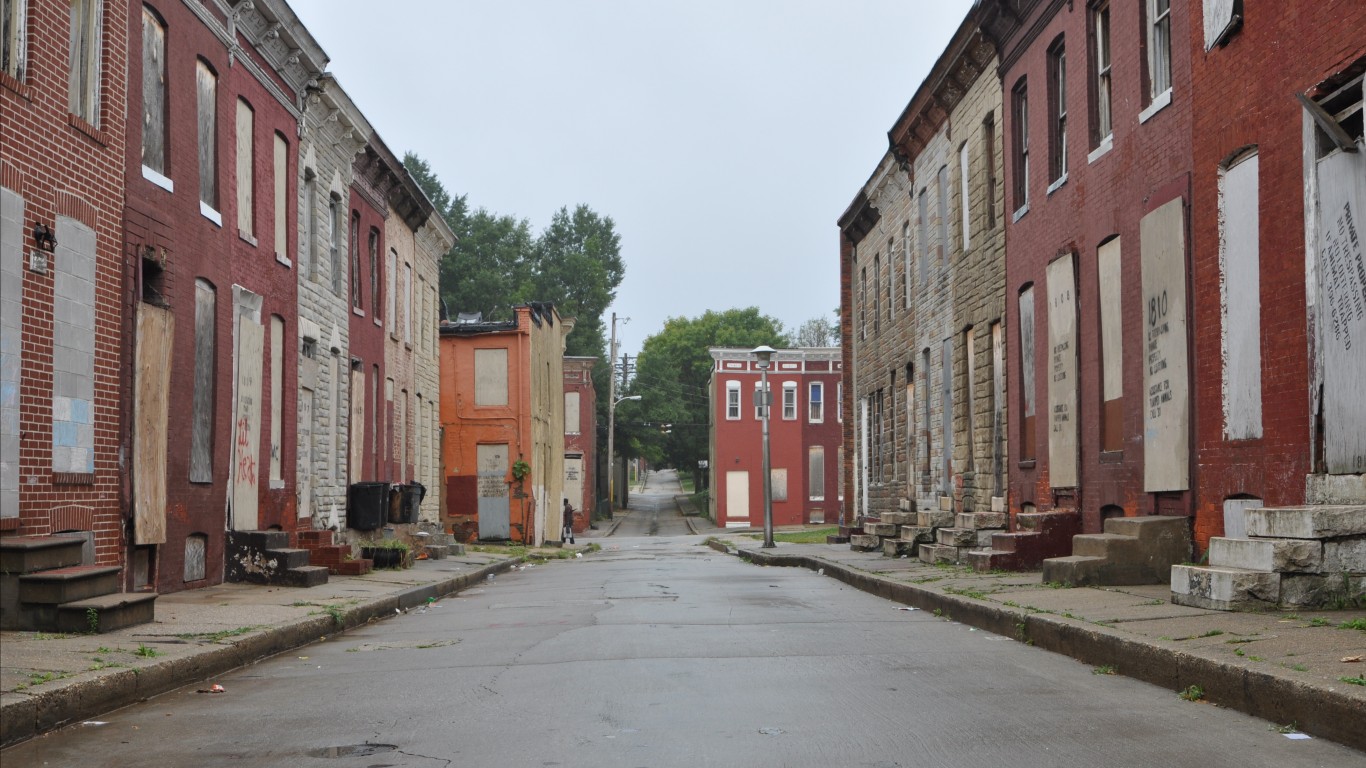
14. ZIP 21217 (Baltimore, Maryland)
> Vacant homes: 2,456 (18.4% of total)
> 5-yr. population change: -14.7%
> Population: 34,487
> Median home value: $124,800
Situated on the south side of Druid Hill Park in central Baltimore, the 21217 ZIP code covers the city’s Reservoir Hill, Penn North, Druid Heights, Bolton Hill, and Upton neighborhoods. Across Baltimore as a whole, there are about 18,000 vacant properties. The city’s high vacancy rate has been driving up crime and dragging down property values for about a decade. In the 21217 ZIP code alone, 18.4% of all residences are vacant.
Of the nearly 2,500 vacant homes in the area, however, more than 1,744 are classified as investment properties, which suggests that their owners may be trying to rent them or waiting for them to appreciate to sell.
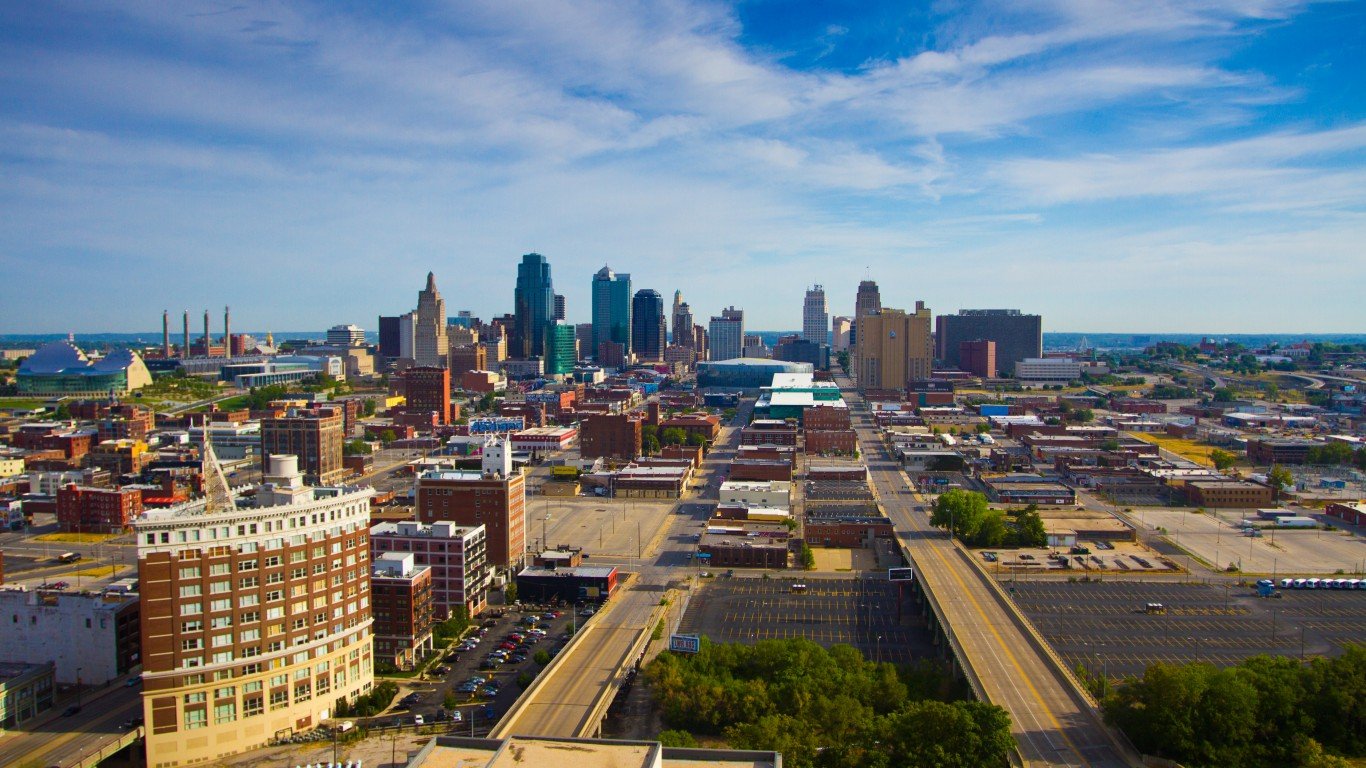
13. ZIP 64128 (Kansas City, Missouri)
> Vacant homes: 944 (19.1% of total)
> 5-yr. population change: -7.8%
> Population: 11,379
> Median home value: $41,000
The 64128 ZIP code in Kansas City covers the Knoches Park, Oak Park Northwest, Palestine East, and Sante Fe neighborhoods, as well as Ingleside — some of which are among the highest crime areas in the city. These areas also have some of the highest home vacancy rates in the country. The area’s high crime and a high vacancy rate are likely depressing home values. The typical home in the 64128 ZIP code is worth just $41,000, down from $45,800 in 2014.
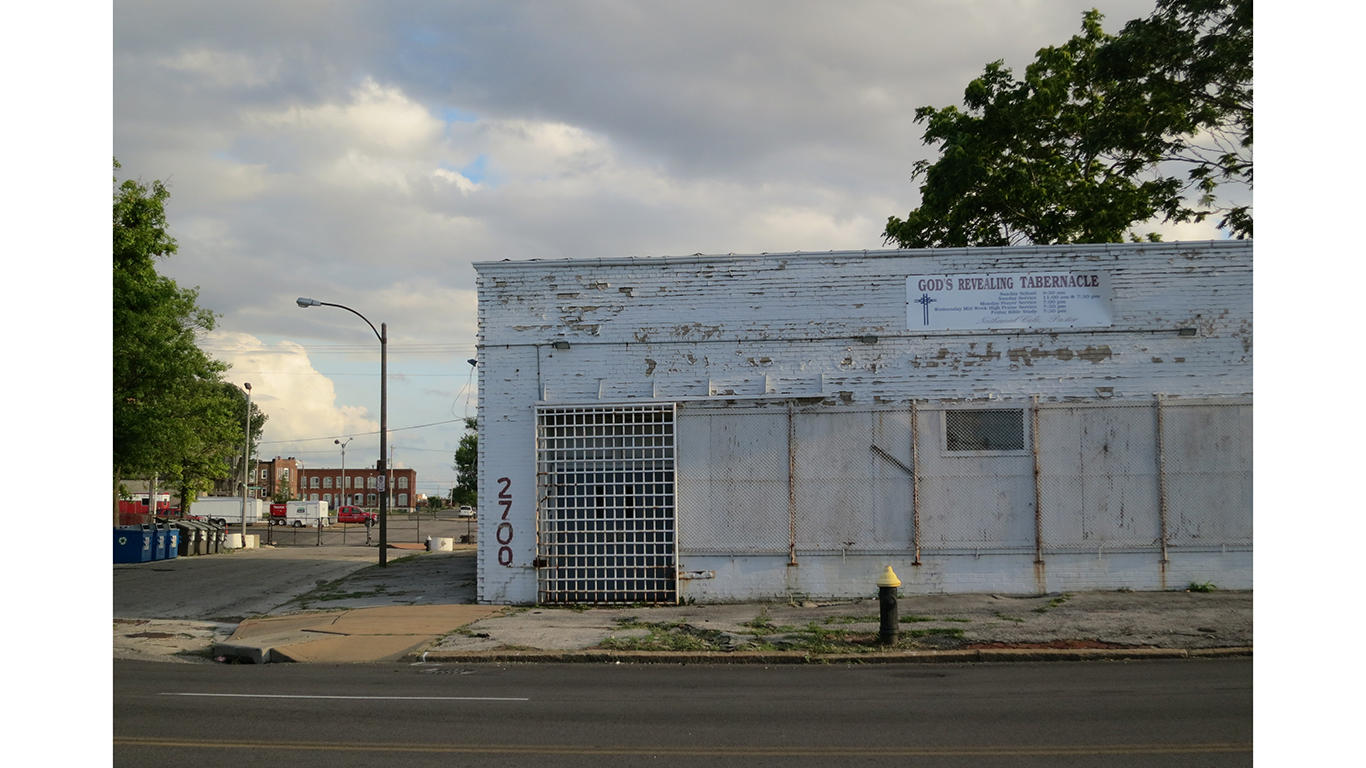
12. ZIP 63113 (St. Louis, Missouri)
> Vacant homes: 874 (19.3% of total)
> 5-yr. population change: -7.1%
> Population: 11,371
> Median home value: $66,800
In the last five years, the number of people living in the 63113 ZIP code — located just north of the Central West End neighborhood in St. Louis — declined by 7.1%. The area’s high vacancy rate of 19.3% is likely partially the result of long-term population decline.
As is often the case, many of the vacant properties in this part of St. Louis are investment properties — meaning they are likely either on the rental market or waiting to be sold at a profit by the owner. If recent trends are any indication, it may be some time before a real estate investment in the area pays off.
[in-text-ad-2]
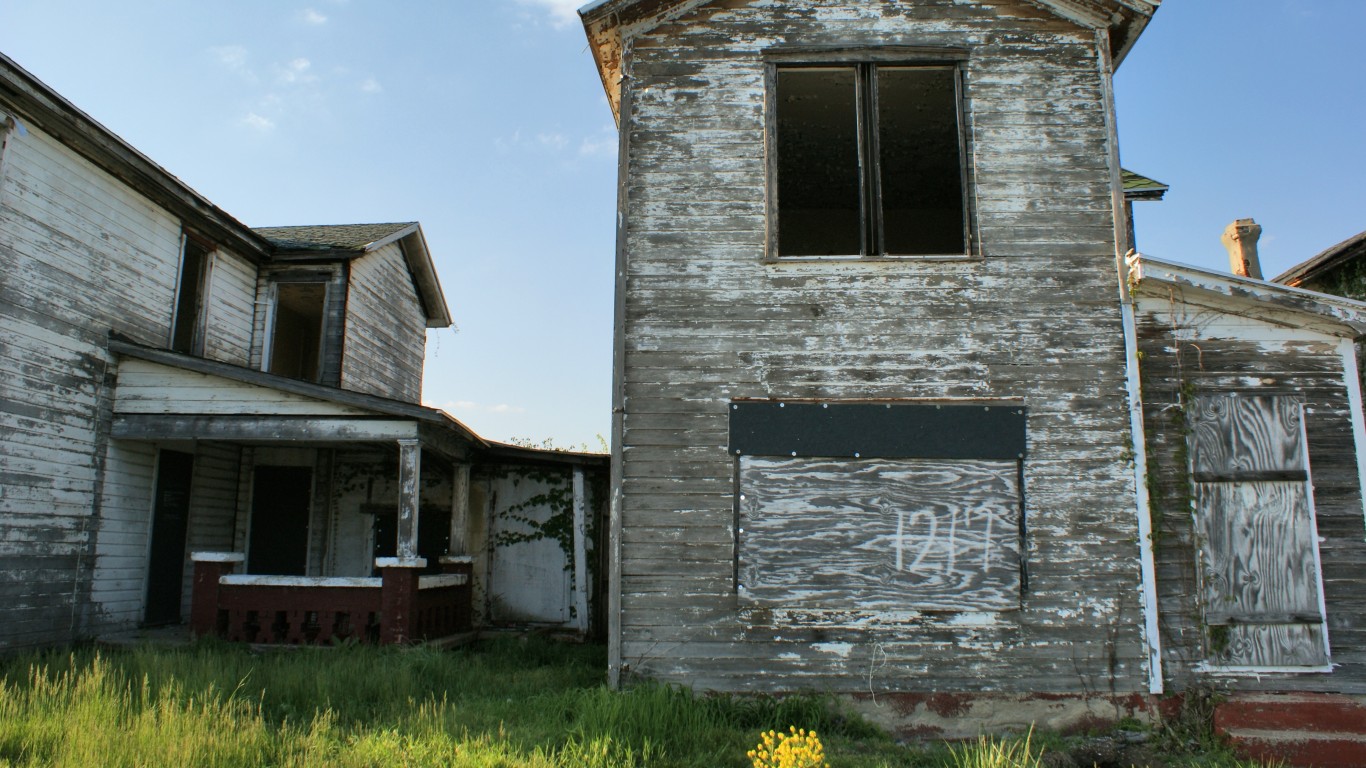
11. ZIP 45402 (Dayton, Ohio)
> Vacant homes: 767 (19.3% of total)
> 5-yr. population change: -4.3%
> Population: 10,053
> Median home value: $57,600
Dayton, Ohio’s 45402 ZIP is centrally located in the city and is bisected by the Miami River. There are currently 767 vacant properties in the area, up from 725 a year ago. The growing vacancy problem is likely due in part to rapid population decline and the resultant reduced demand for housing. In the last five years, the number of people living in the Dayton ZIP code fell by 4.3%.
The area’s population decline is most likely attributable to poor economic conditions. With the typical area household earning less than $27,000 a year and over a third of the population living in poverty, the ZIP code is one of the poorest in the United States.
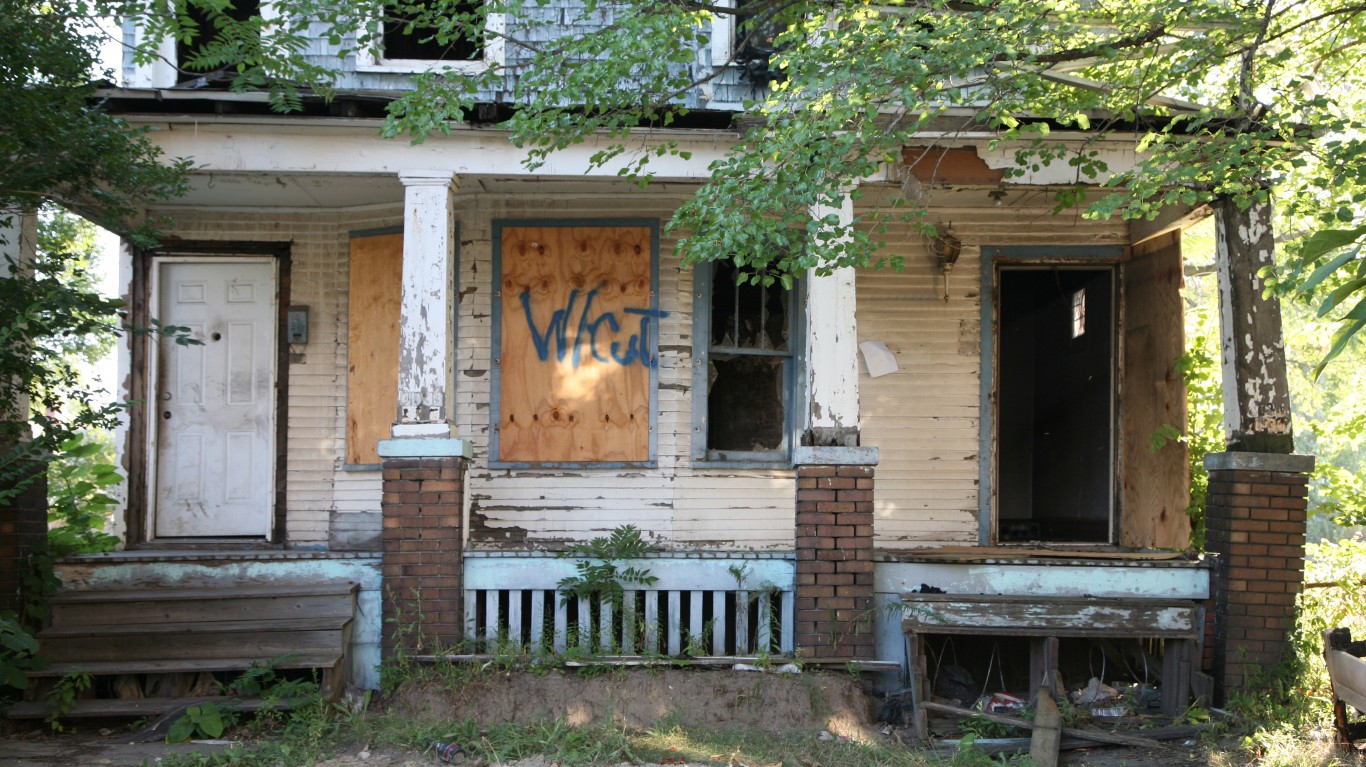
10. ZIP 48504 (Flint, Michigan)
> Vacant homes: 2,151 (19.5% of total)
> 5-yr. population change: -10.6%
> Population: 27,361
> Median home value: $33,100
In a plan to reduce costs, Flint, Michigan, switched its water source from Lake Huron to the Flint River in 2014. Less than a year later, the EPA reported dangerous concentrations of lead in the Flint water supply. The contaminated water resulted in a public health crisis and criminal investigations against city officials.
The water scandal has also likely exacerbated the Rust Belt city’s vacant property crisis. In the last five years, the number of people living in Flint’s 48504 ZIP code declined by 10.6% and area real estate values plummeted. Currently, more than 2,100 homes in the area in the northwestern section of the city are vacant.
[in-text-ad]

9. ZIP 44108 (Cleveland, Ohio)
> Vacant homes: 1,678 (20.1% of total)
> 5-yr. population change: -13.5%
> Population: 21,939
> Median home value: $57,400
The 44108 ZIP code is located in northeastern Cleveland along the shore of Lake Erie. In the last five years, the number of people living in the area fell by 13.5%. The rapid population decline has led to reduced demand for housing, which has likely dragged down home values. The typical area home is worth just $57,400, down from $63,800 in 2014.
Like most ZIP codes on this list, 44108 is in a city that has long suffered economically from the decline of American manufacturing. Since factories began to close in the mid-20th century, the city’s population has more than halved, from over 900,000 as of 1950 to less than 400,000 today.
8. ZIP 39203 (Jackson, Mississippi)
> Vacant homes: 390 (20.4% of total)
> 5-yr. population change: -4.6%
> Population: 6,360
> Median home value: $48,600
Few parts of the United States are home to as much widespread financial hardship as the 39203 ZIP code around downtown Jackson, Mississippi. Nearly 39% of area residents live below the poverty line, and most households earn less than $24,000 a year.
Many of the poorest areas in the United States have high vacancy rates, and this part of the Mississippi state capital is no exception. More than one in every five homes in the area are vacant, compared to just 1.6% of homes nationwide.

7. ZIP 48206 (Detroit, Michigan)
> Vacant homes: 1,114 (20.9% of total)
> 5-yr. population change: -25.7%
> Population: 15,745
> Median home value: $49,800
Detroit’s 48206 ZIP code is contained almost entirely by I-94 and I-96 on the south and west and by routes 10 and 8 on the east and north. Few cities have been hit as hard by the decline of American manufacturing as Detroit, and the 48206 ZIP code is evidence of that decline. There are over 1,100 vacant homes in the area, or one in every five area homes.
The high home vacancy rate has likely been exacerbated by population decline. In the last five years, the number of people living in the area fell by 25.7%. The rapid population decline is likely due in part to a lack of economic opportunity. Over 43%% of area residents live below the poverty line, and more than half of all local households earn less than $23,000 annually.
[in-text-ad-2]

6. ZIP 36104 (Montgomery, Alabama)
> Vacant homes: 626 (25.5% of total)
> 5-yr. population change: -6.6%
> Population: 8,342
> Median home value: $73,500
The 36104 ZIP code in northern Montgomery, Alabama, along Gun Island Chute, has a near nation-leading home vacancy rate. There are 626 vacant properties in the area — or one in every four — up from 591 a year ago. Of the vacant homes, 514 are classified as investment properties — meaning they are likely either on the rental market or waiting to be sold at a profit by the owner.
However, property values are falling in the area. The typical home in the ZIP code is worth $73,500, down from $74,200 last year, and $79,000 in 2014.
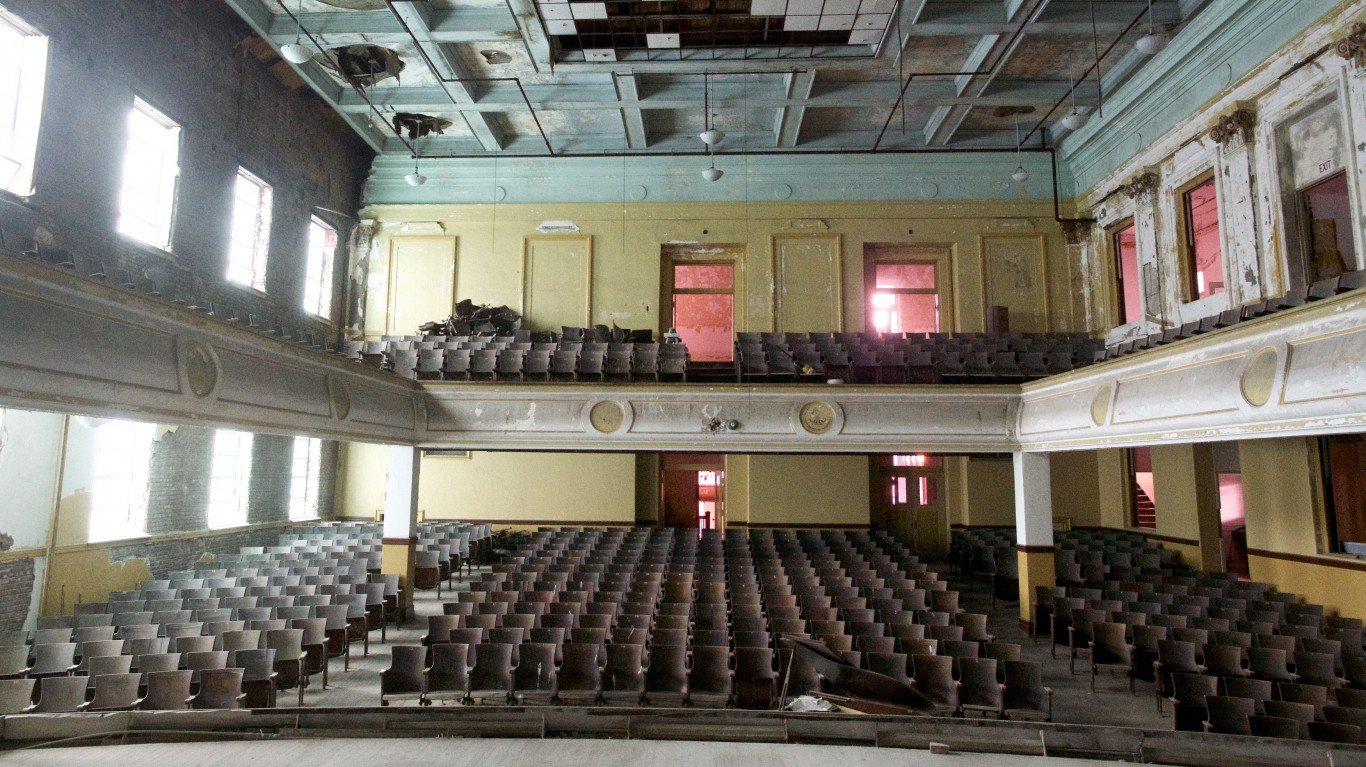
5. ZIP 17976 (Shenandoah, Pennsylvania)
> Vacant homes: 856 (26.9% of total)
> 5-yr. population change: -5.7%
> Population: 6,531
> Median home value: $40,700
Pennsylvania’s 17976 ZIP code comprises the borough of Shenandoah, about 120 miles west of New York City. An economically depressed area, Shenandoah has a poverty rate of 35.5%. Additionally, over half of all area homes are worth less than $41,000. Low property values and high vacancy rates tend to go hand in hand, and in Shenandoah, there are 856 vacant dwellings — nearly 27% of homes.
A coal mining town in the early 1900s, Shenandoah has been in decline since the industry all but shut down over half a century ago.
[in-text-ad]
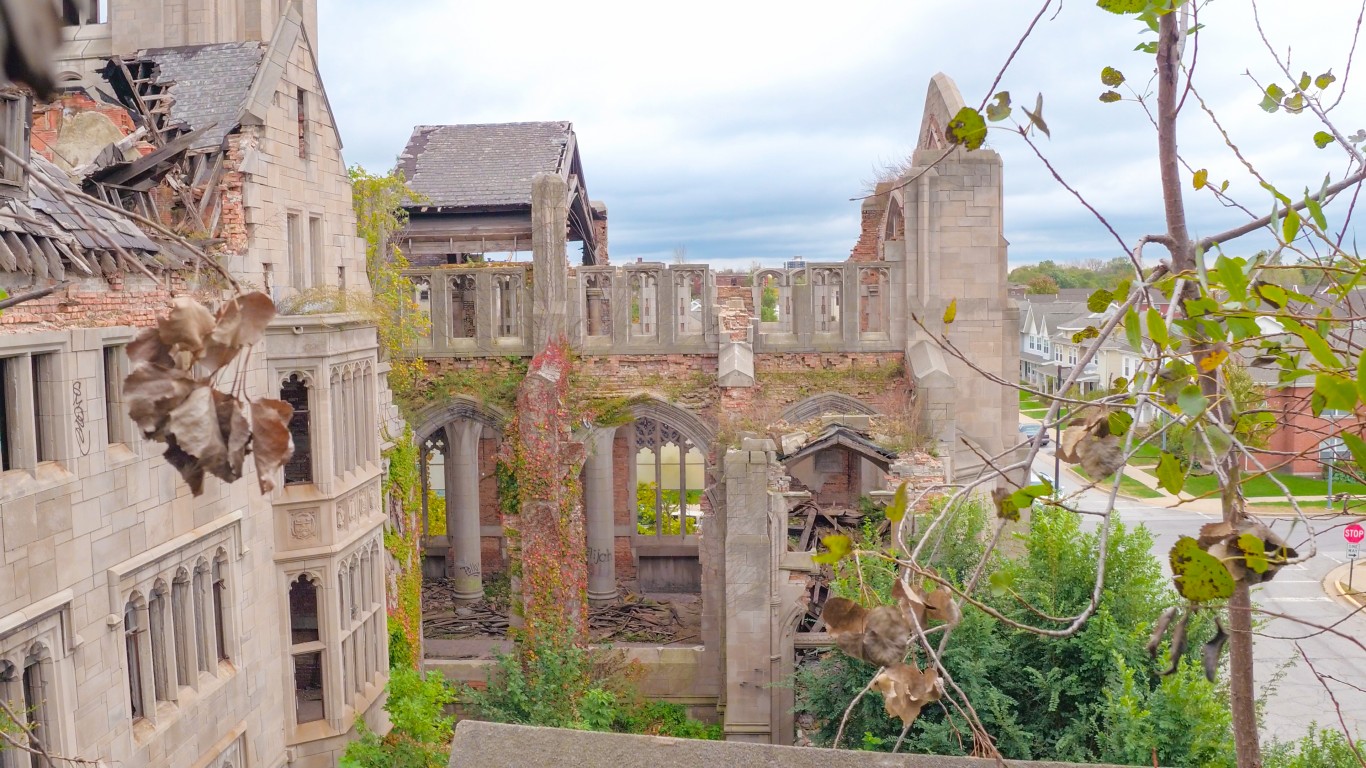
4. ZIP 46407 (Gary, Indiana)
> Vacant homes: 1,241 (27.6% of total)
> 5-yr. population change: -11.4%
> Population: 11,345
> Median home value: $50,300
Bisected by Route 53 and with I-94 along the southern border, 46407 is one of several ZIP codes in Gary, Indiana, with a vacancy rate high enough to rank on this list. Some 27.6% of residential properties in the area are vacant, compared to just 1.6% of homes nationwide.
People have been leaving the area in droves in recent years. Between 2013 and 2018, the number of people living in the ZIP code fell from 12,798 to 11,324, an 11.4% decline. Over the same period, with waning demand for housing, the median home value in the area fell substantially, from $53,500 to $50,300.
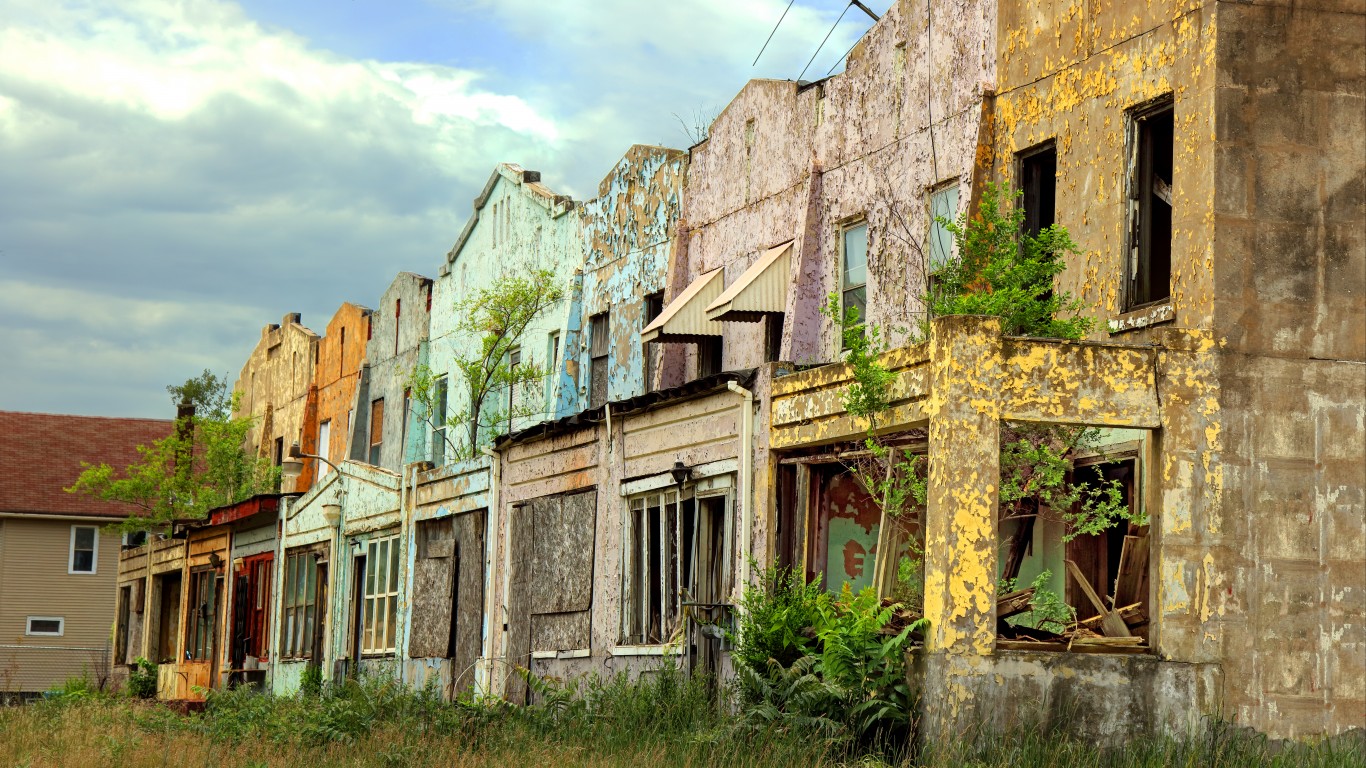
3. ZIP 46409 (Gary, Indiana)
> Vacant homes: 1,201 (31.3% of total)
> 5-yr. population change: -19.7%
> Population: 7,350
> Median home value: $59,400
The 46409 ZIP code is bordered by Route 53, I-94, and I-65 in southern Gary, Indiana. Some 1,201 homes in the area are vacant, a slight increase from a year ago, when 1,190 area homes were vacant. Like many neighborhoods on this list, the 46409 ZIP code is economically distressed. Nearly one in every three residents live below the poverty line, more than double the 13.4% national poverty rate.
Gary is one of several once-great American manufacturing hubs that have suffered economic and population declines. Over the last five years alone, the number of people living in the 46409 ZIP code fell by a staggering 19.7%.
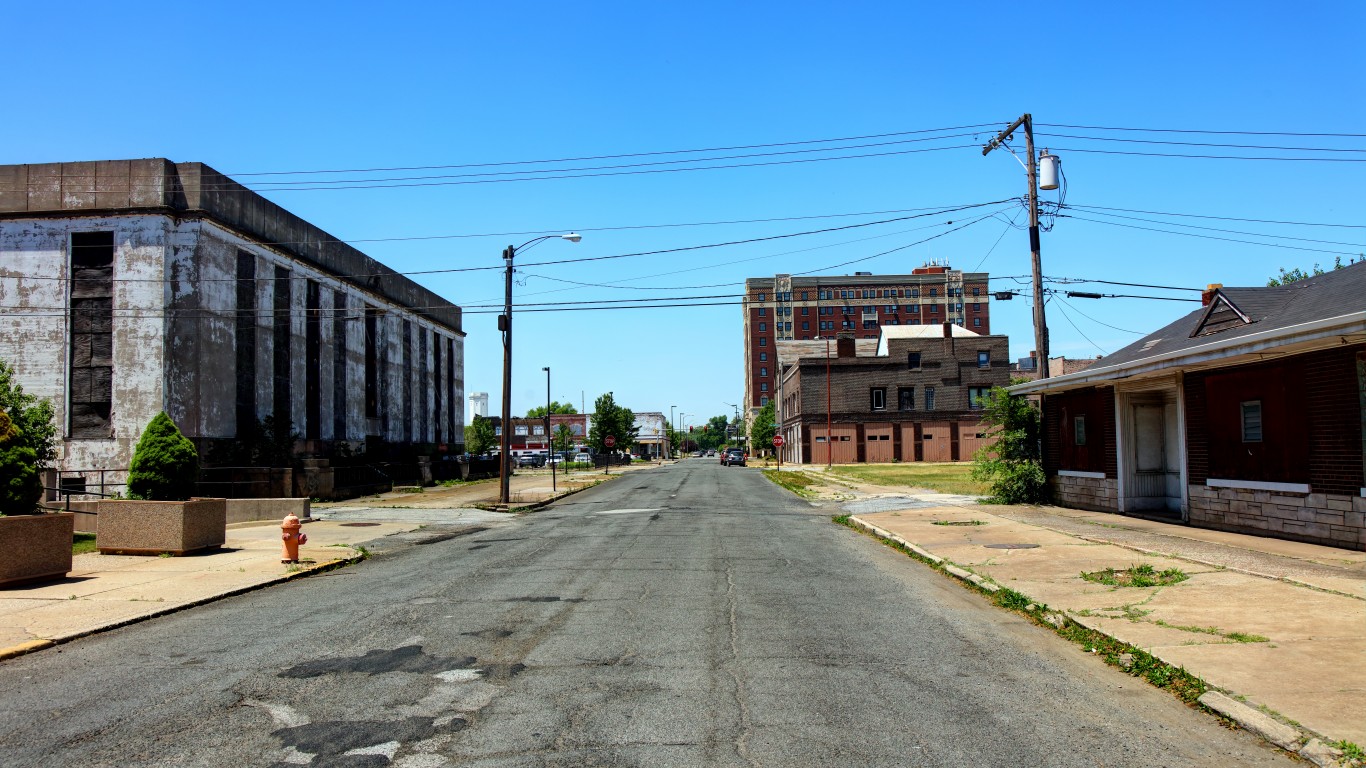
2. ZIP 46402 (Gary, Indiana)
> Vacant homes: 654 (31.8% of total)
> 5-yr. population change: -2.5%
> Population: 6,436
> Median home value: $63,000
Of the several neighborhoods in Gary, Indiana, to rank on this list, none has a larger share of vacant homes than the 46402 ZIP, which extends from Central Ave to the Lake Michigan shore. More than 650 properties in the area are vacant, and the availability of residential space has likely driven down home prices. The typical home in the ZIP code is worth just $63,000, not even a third of the median home value of $204,900 nationwide.
Low home values have created an opportunity for real estate investors in the area. Some 456 vacant homes in the area are classified as investment properties.
[in-text-ad-2]
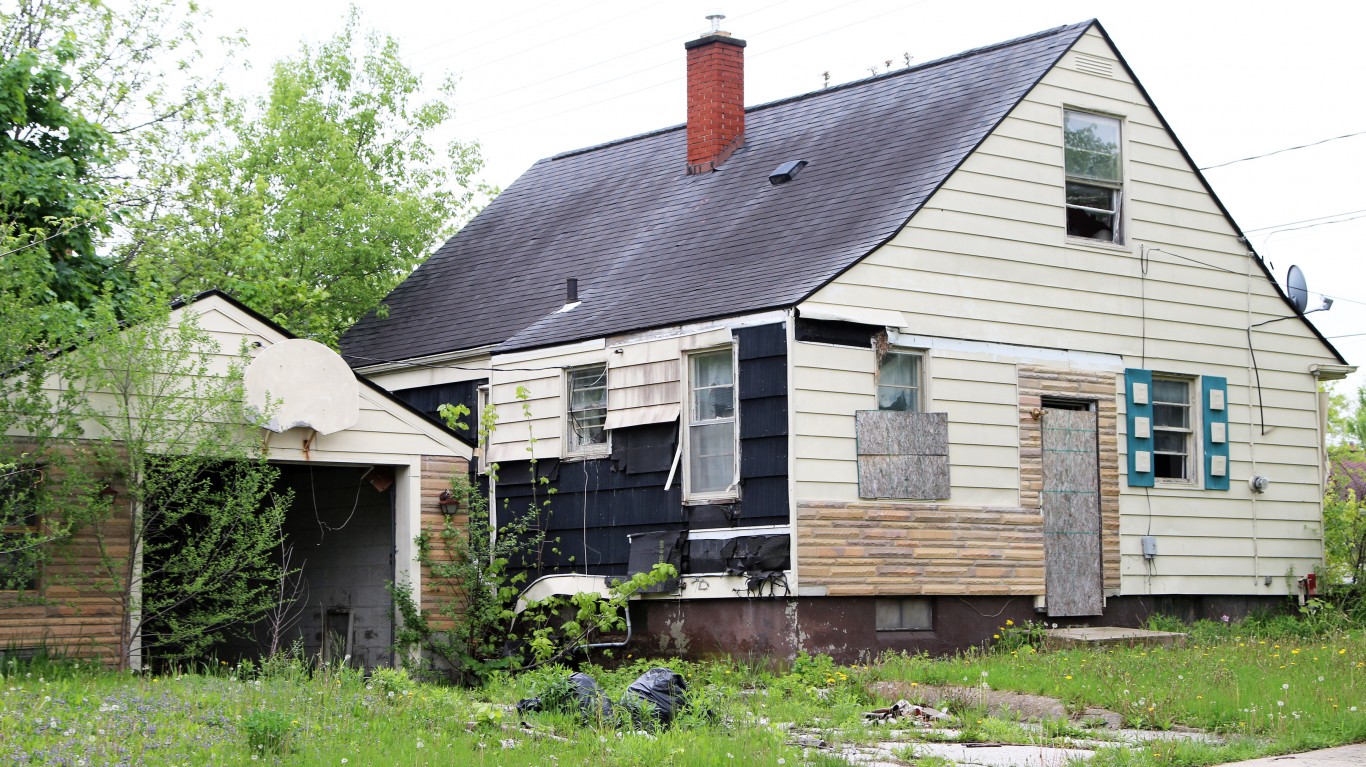
1. ZIP 48505 (Flint, Michigan)
> Vacant homes: 3,431 (33.9% of total)
> 5-yr. population change: -11.3%
> Population: 20,696
> Median home value: $22,400
Few parts of the country have known the level of urban decay that Flint, Michigan, has in recent years. The city, which was already economically distressed following the declining presence of General Motors as a major employer in the city, was hit with a public health crisis after it was discovered in 2015 that the city’s water supply was contaminated with dangerous levels of lead.
The crisis pushed many residents out of the city and provided little incentive for any would-be buyers to invest in area real estate. In the last five years, the number of people living in the 48505 ZIP code, located just north of downtown Flint, fell by more than 11%. Currently, the typical household in the ZIP code is worth just $22,400, and more than a third of area homes are vacant, the largest share of any ZIP code considered.
Methodology
To identify America’s 30 ghost towns, 24/7 Wall St. reviewed the share of single-family homes and condos that are unoccupied in 16,231 ZIP codes with at least 1,000 single family homes and condos. Occupancy status was determined by ATTOM Data Solutions using tax assessor data for the end of the third quarter of 2020.
To better identify areas with vacancy rates that remain high year round and are not likely to decrease significantly in the near future, we only considered ZIP codes with five-year population growth of less than 5%. We also excluded ZIP codes in beach towns and other vacation destinations where vacancy rates are affected by the season.
Median household income, median home value, poverty rates, and population at the ZIP code level are all five-year estimates from the U.S. Census Bureau’s 2018 American Community Survey. Five-year changes in population and median home value are for between 2013 and 2018 are also from the ACS. Violent crime and homicide rates at the metro area level are from the FBI’s 2019 Uniform Crime Report.
Sponsored: Want to Retire Early? Here’s a Great First Step
Want retirement to come a few years earlier than you’d planned? Or are you ready to retire now, but want an extra set of eyes on your finances?
Now you can speak with up to 3 financial experts in your area for FREE. By simply clicking here you can begin to match with financial professionals who can help you build your plan to retire early. And the best part? The first conversation with them is free.
Click here to match with up to 3 financial pros who would be excited to help you make financial decisions.
Thank you for reading! Have some feedback for us?
Contact the 24/7 Wall St. editorial team.
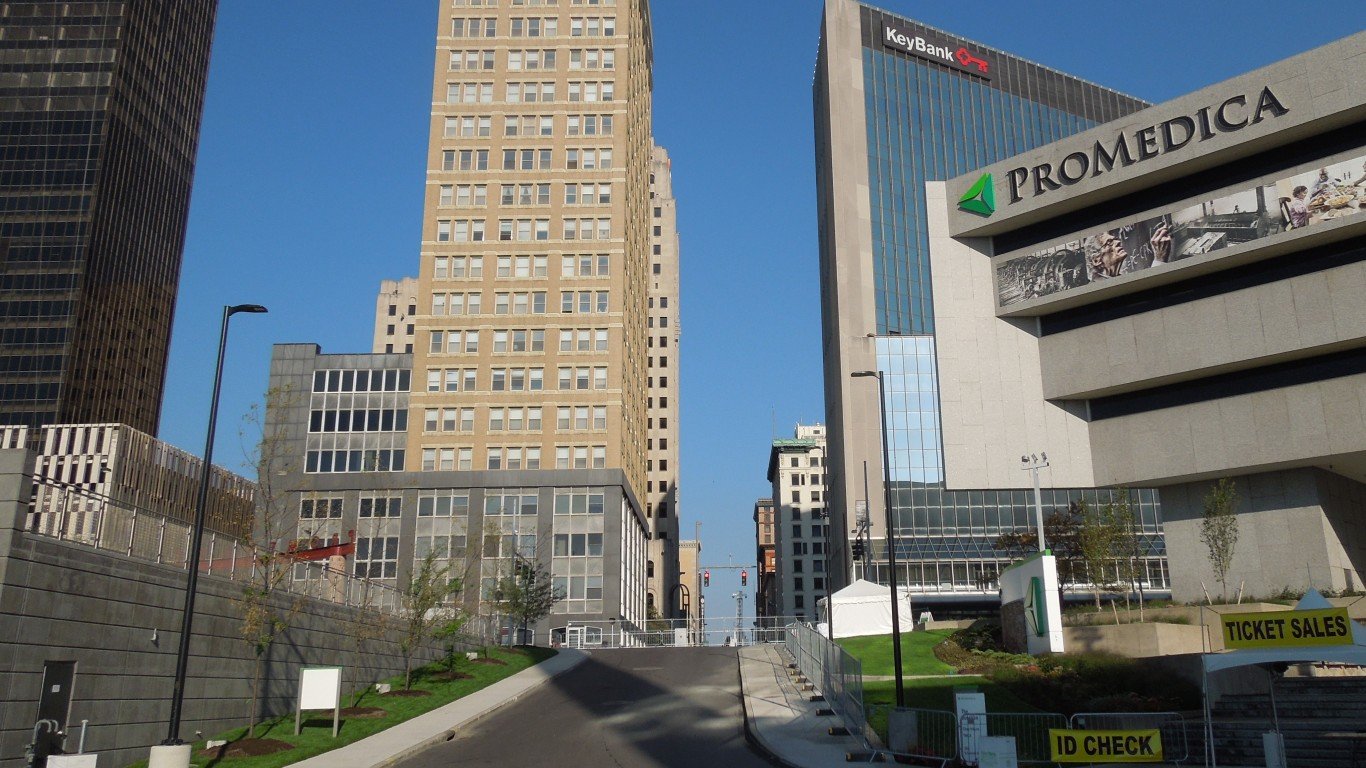
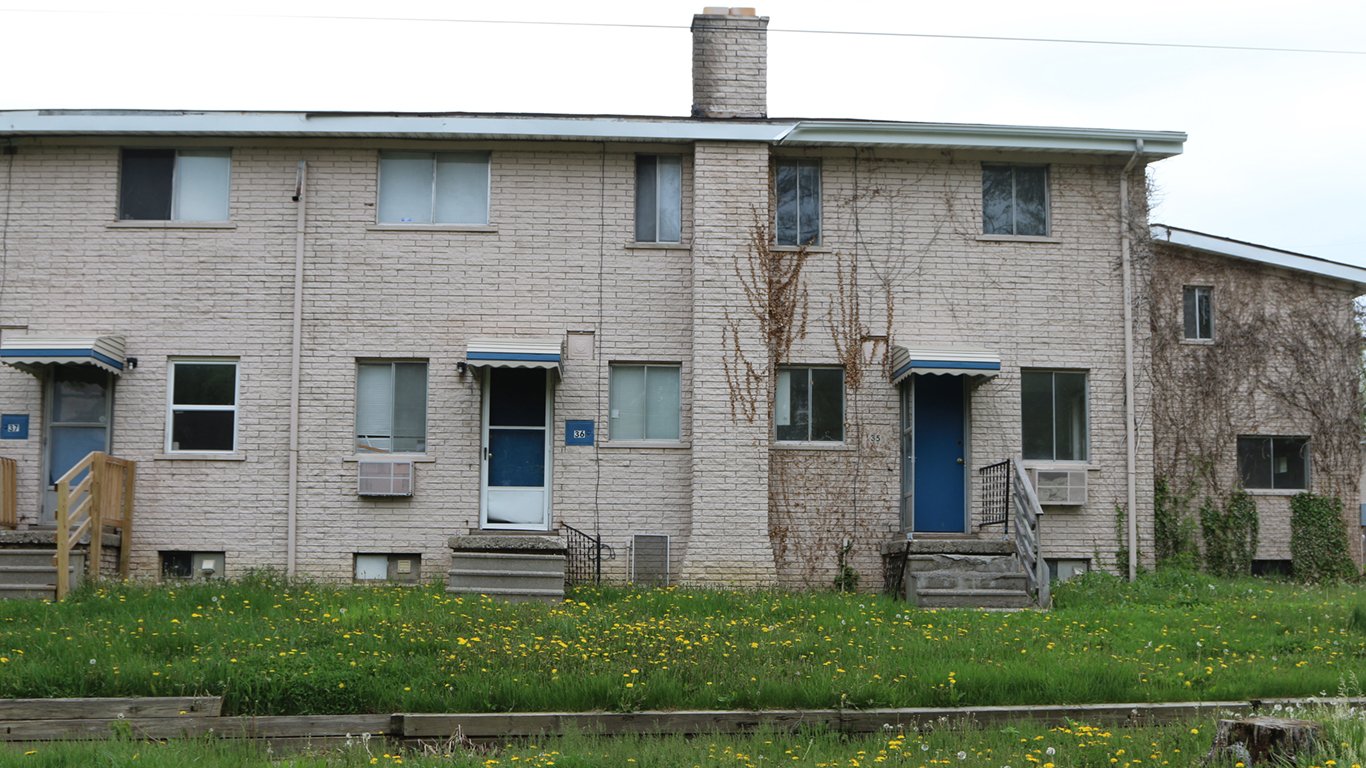 24/7 Wall St.
24/7 Wall St.
 24/7 Wall St.
24/7 Wall St.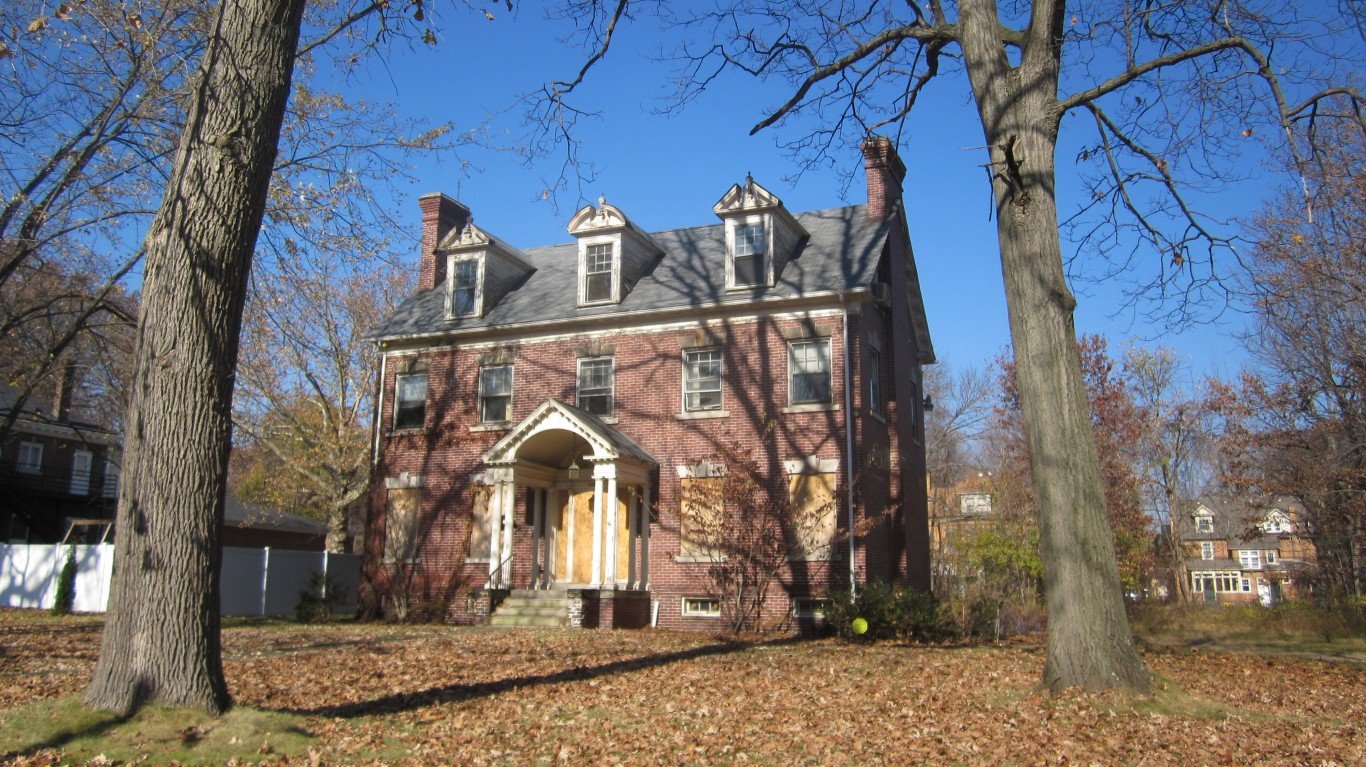
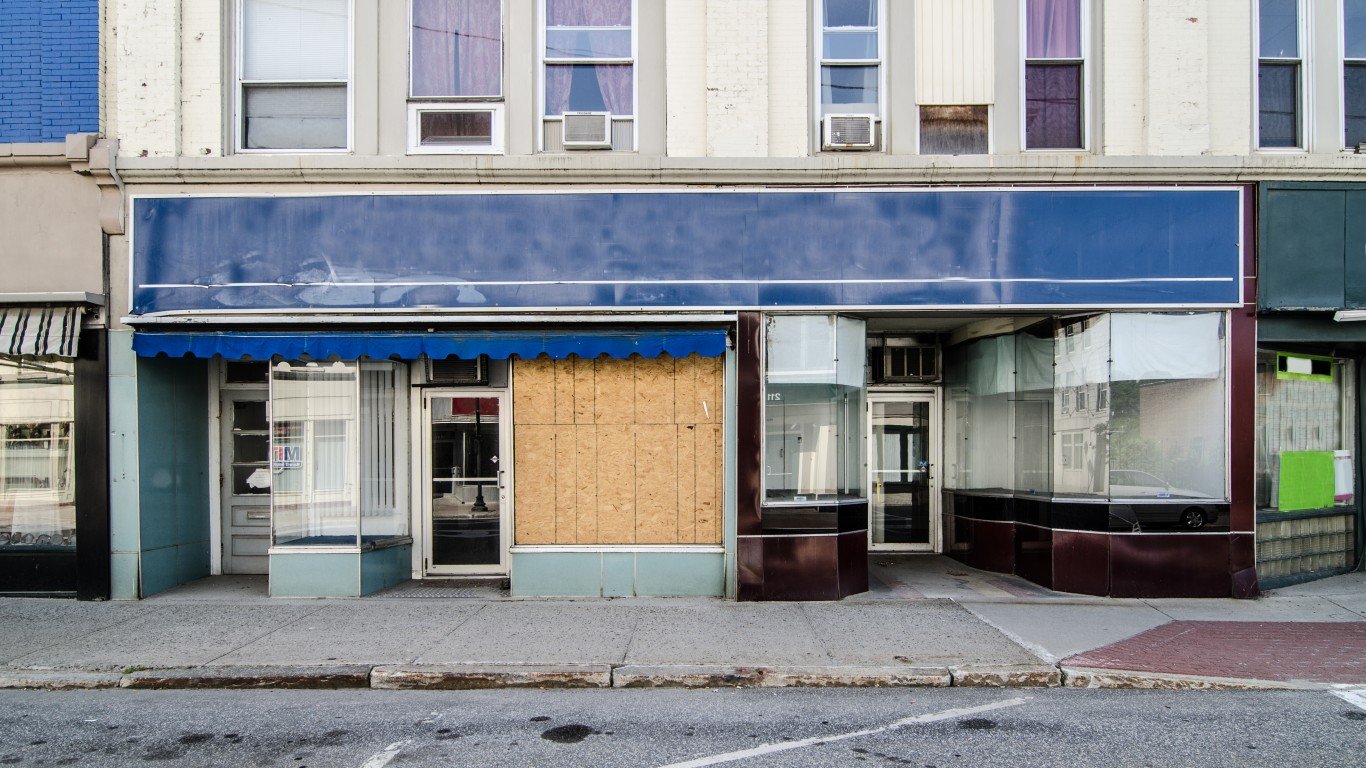 24/7 Wall St.
24/7 Wall St.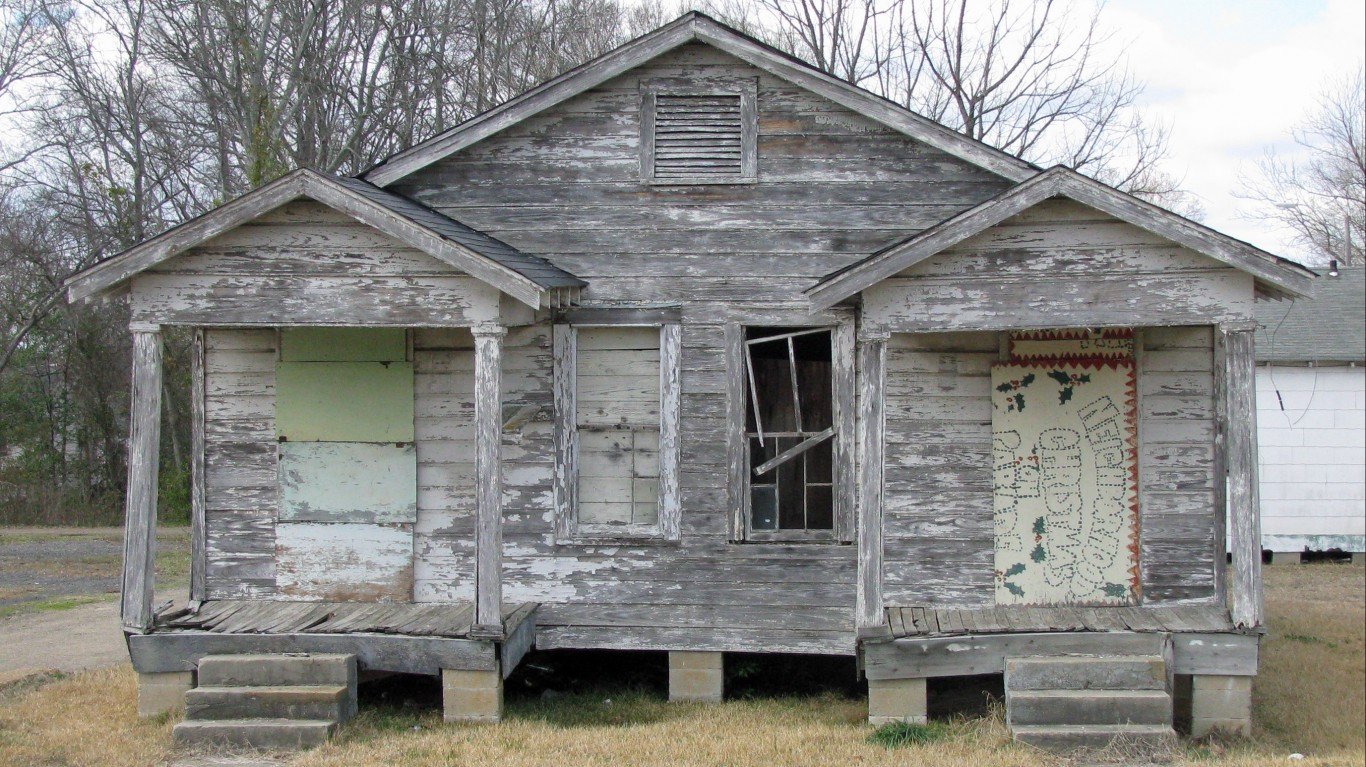
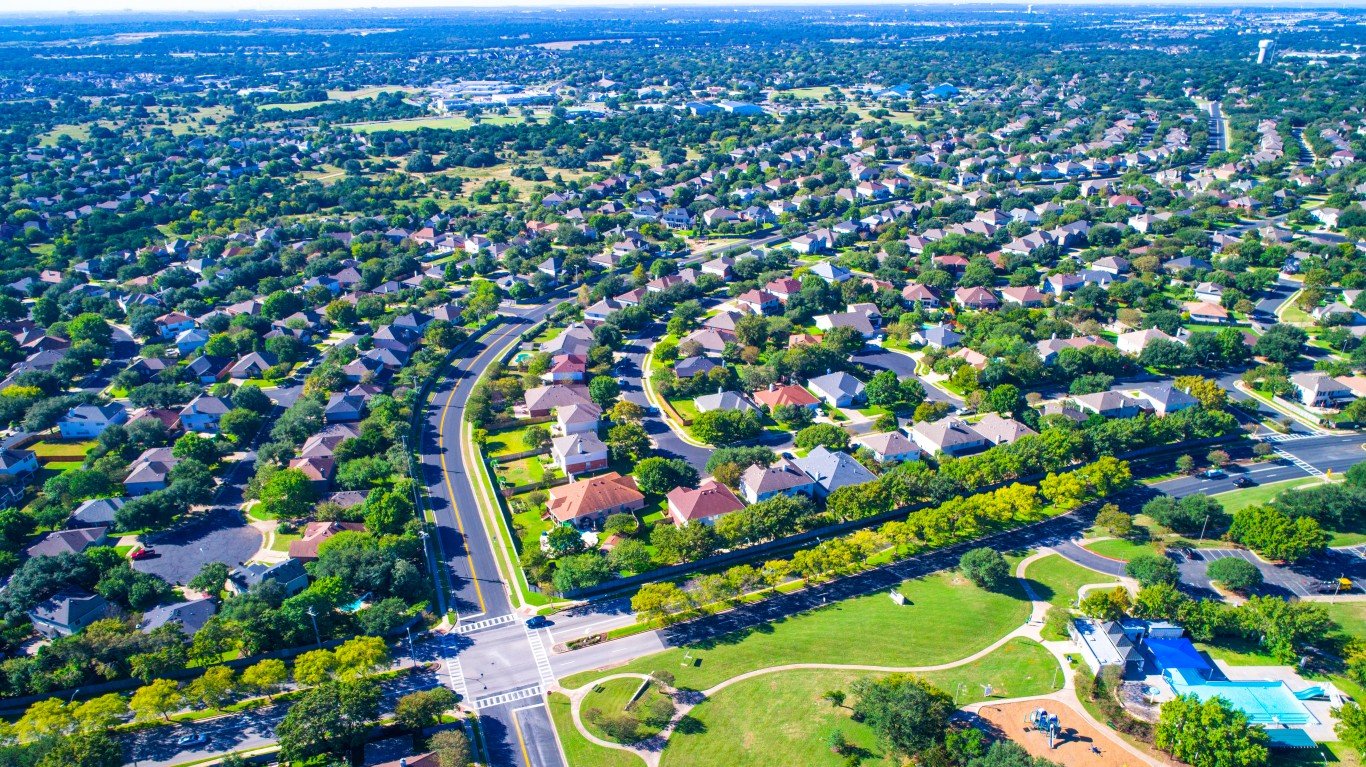 24/7 Wall St.
24/7 Wall St.